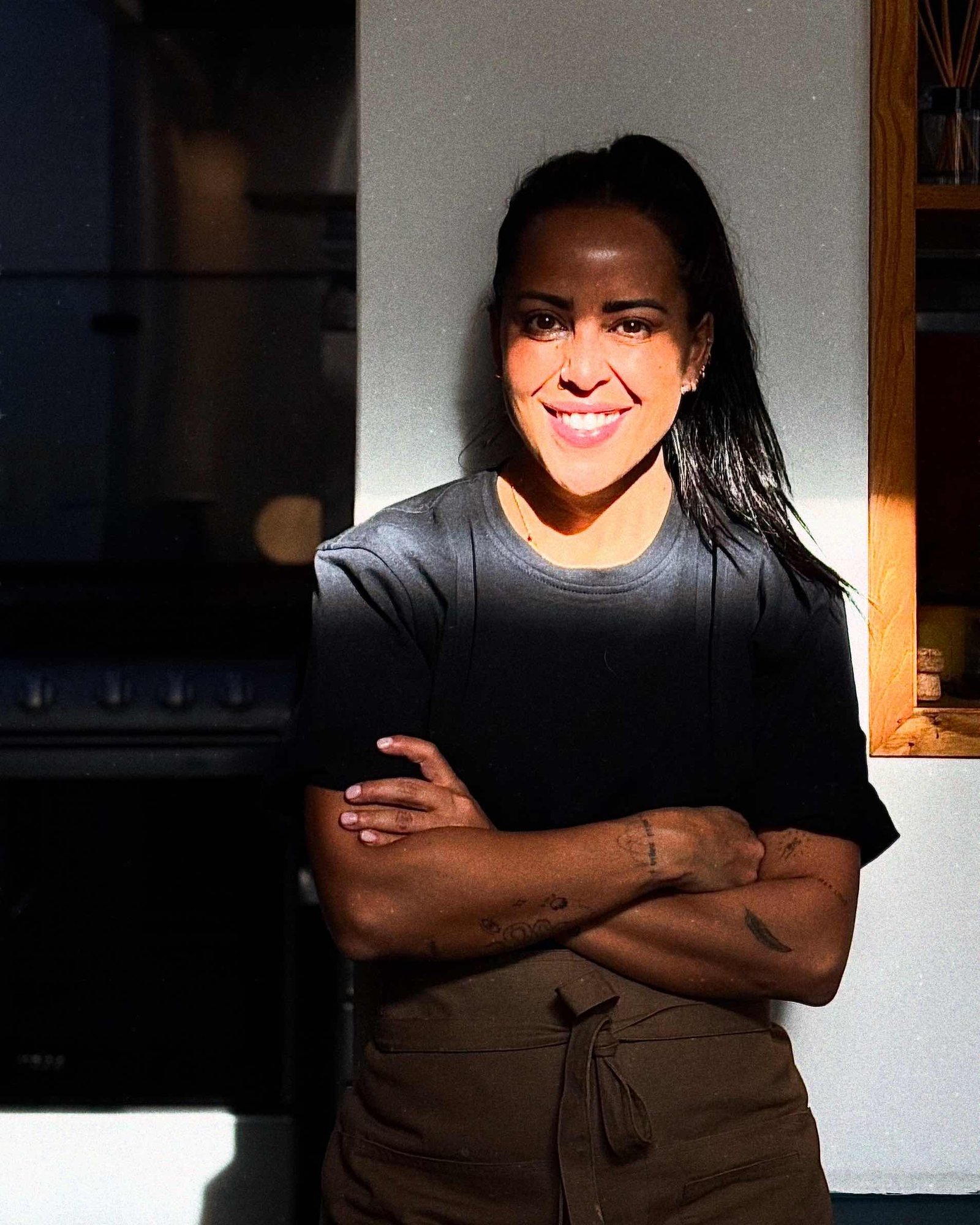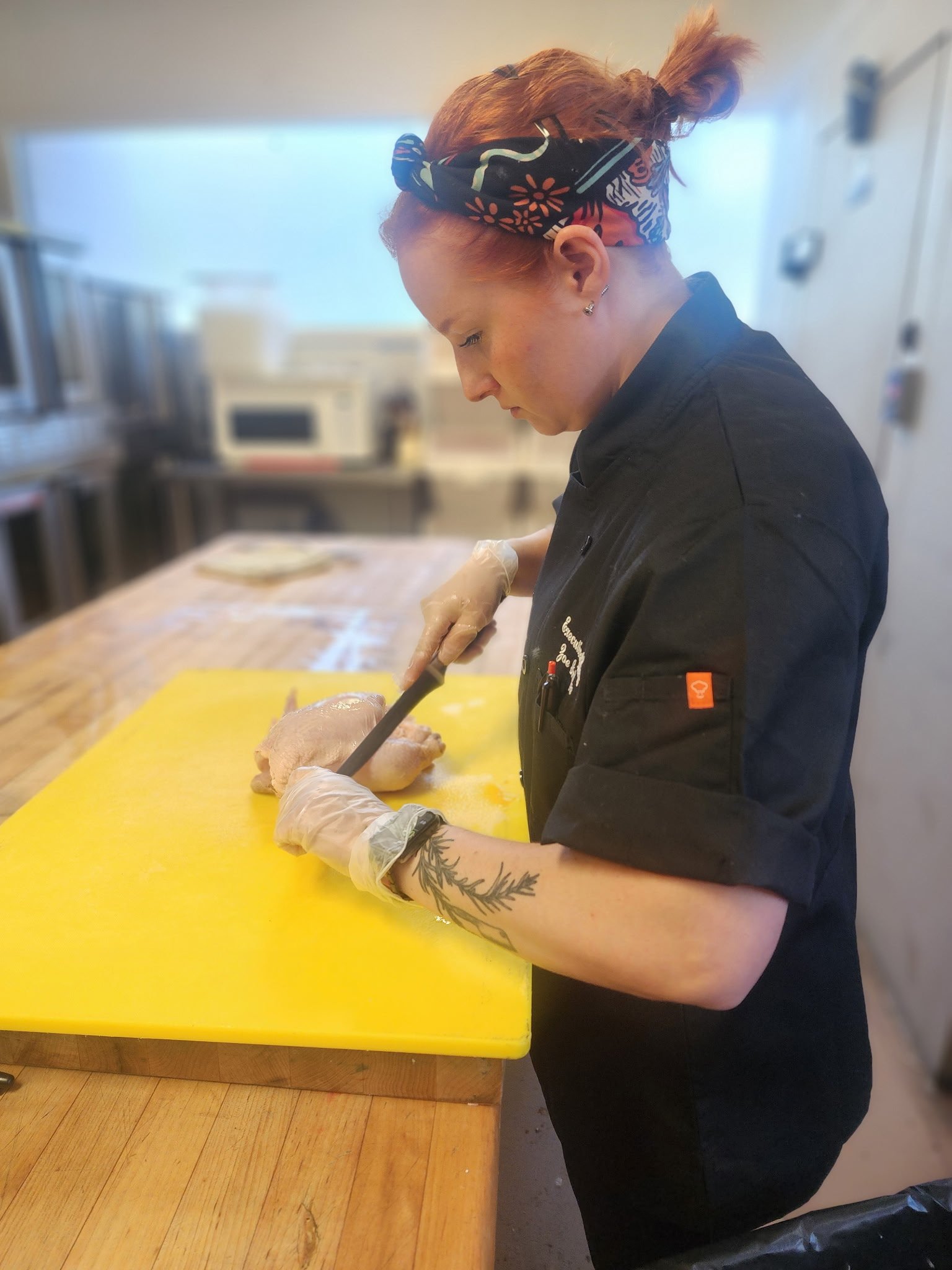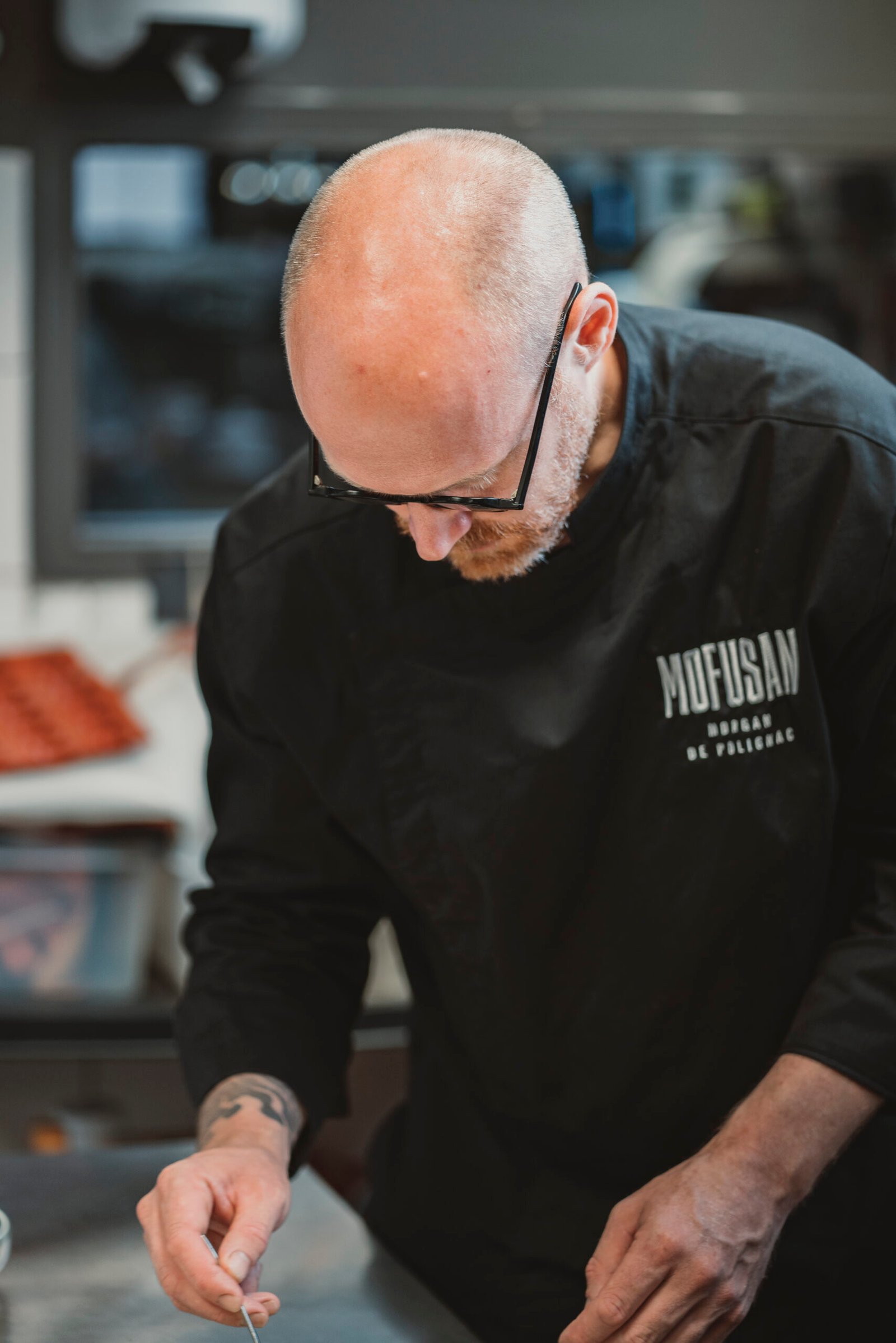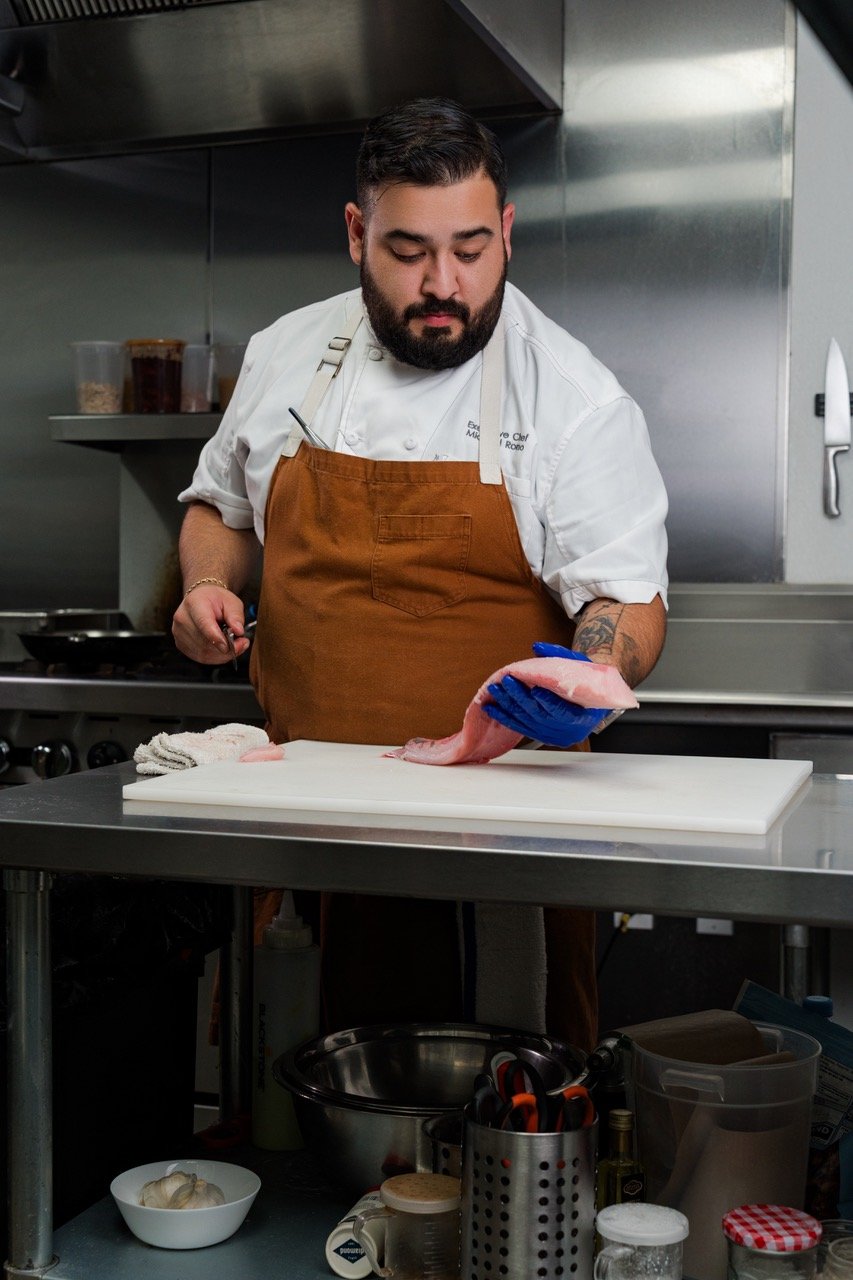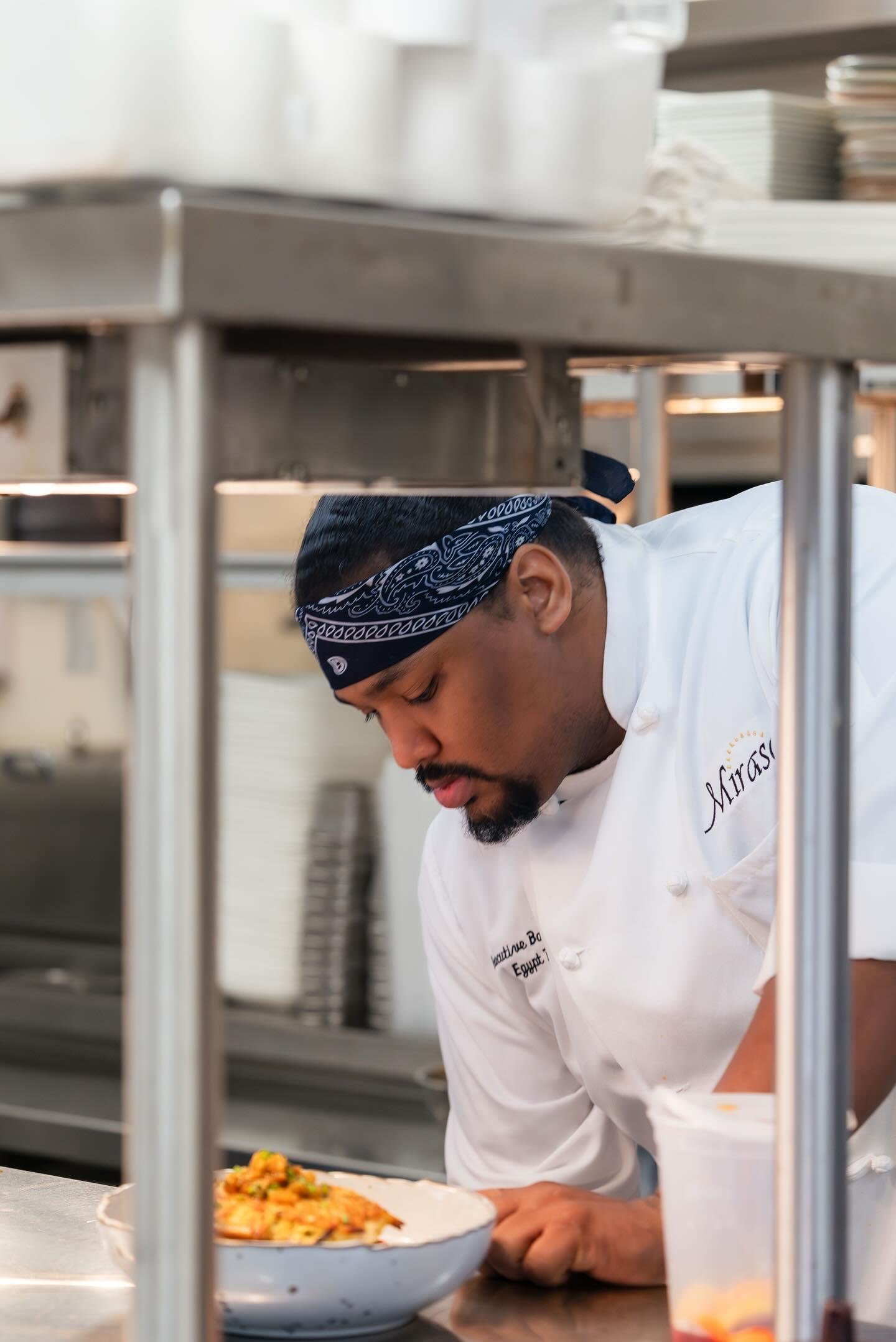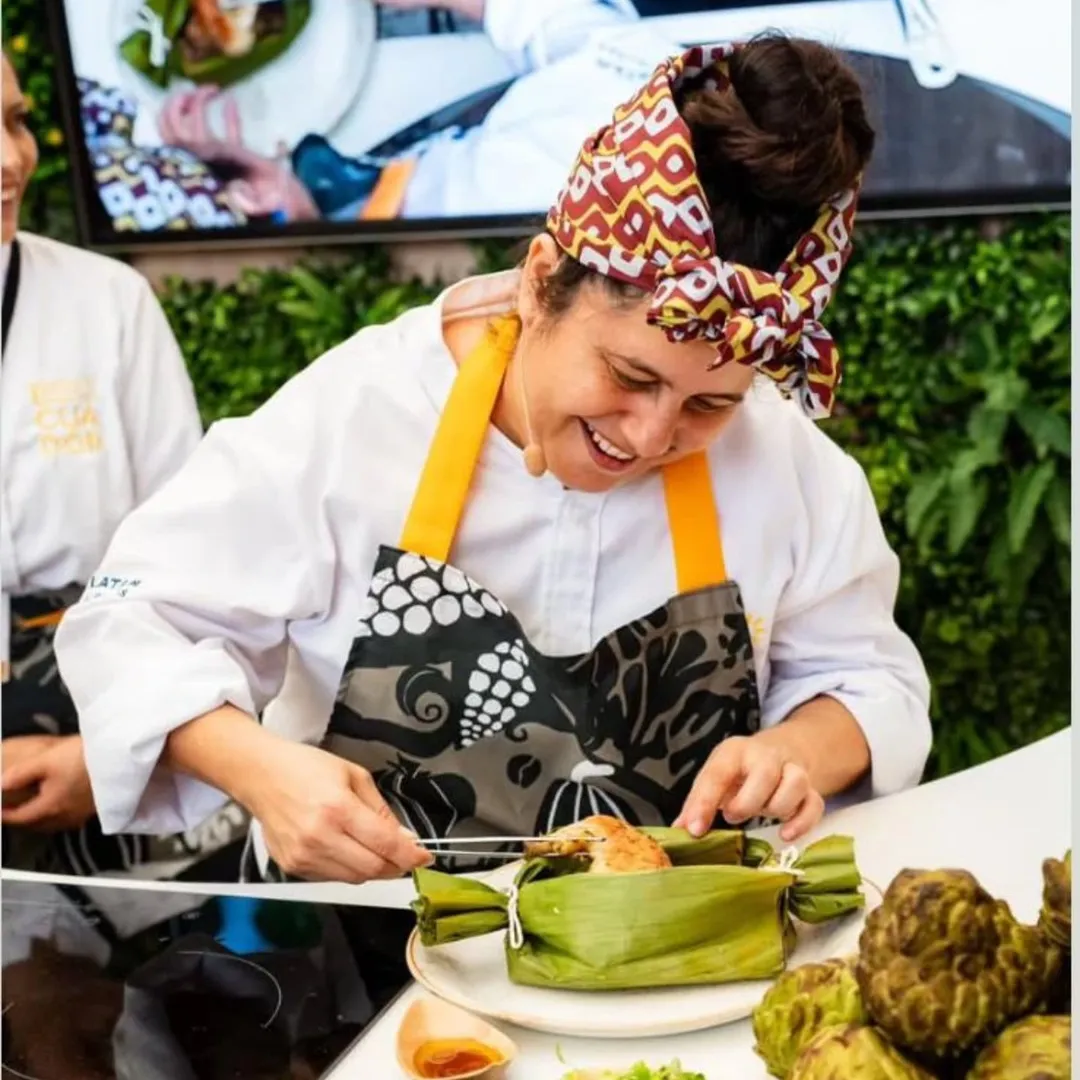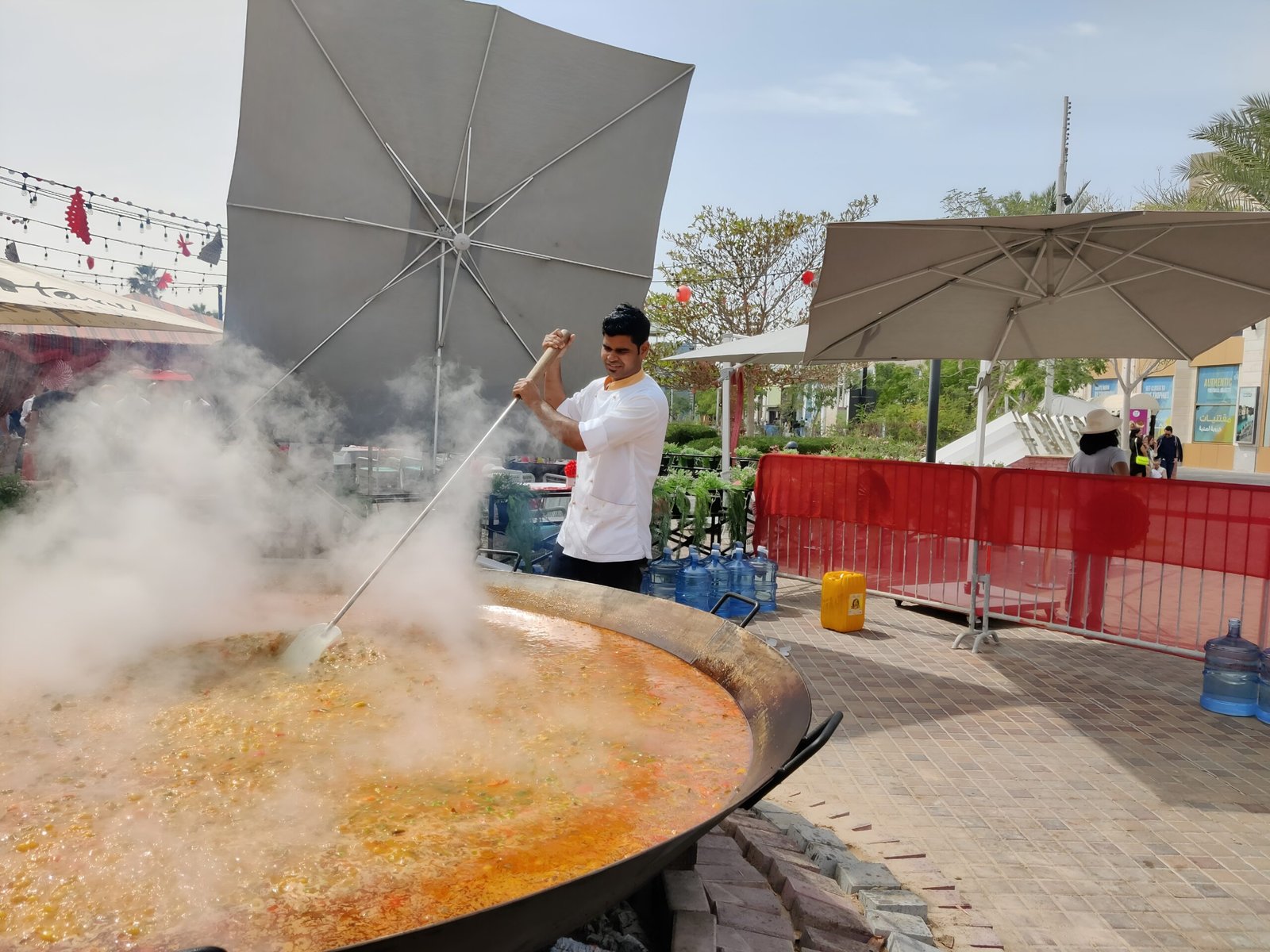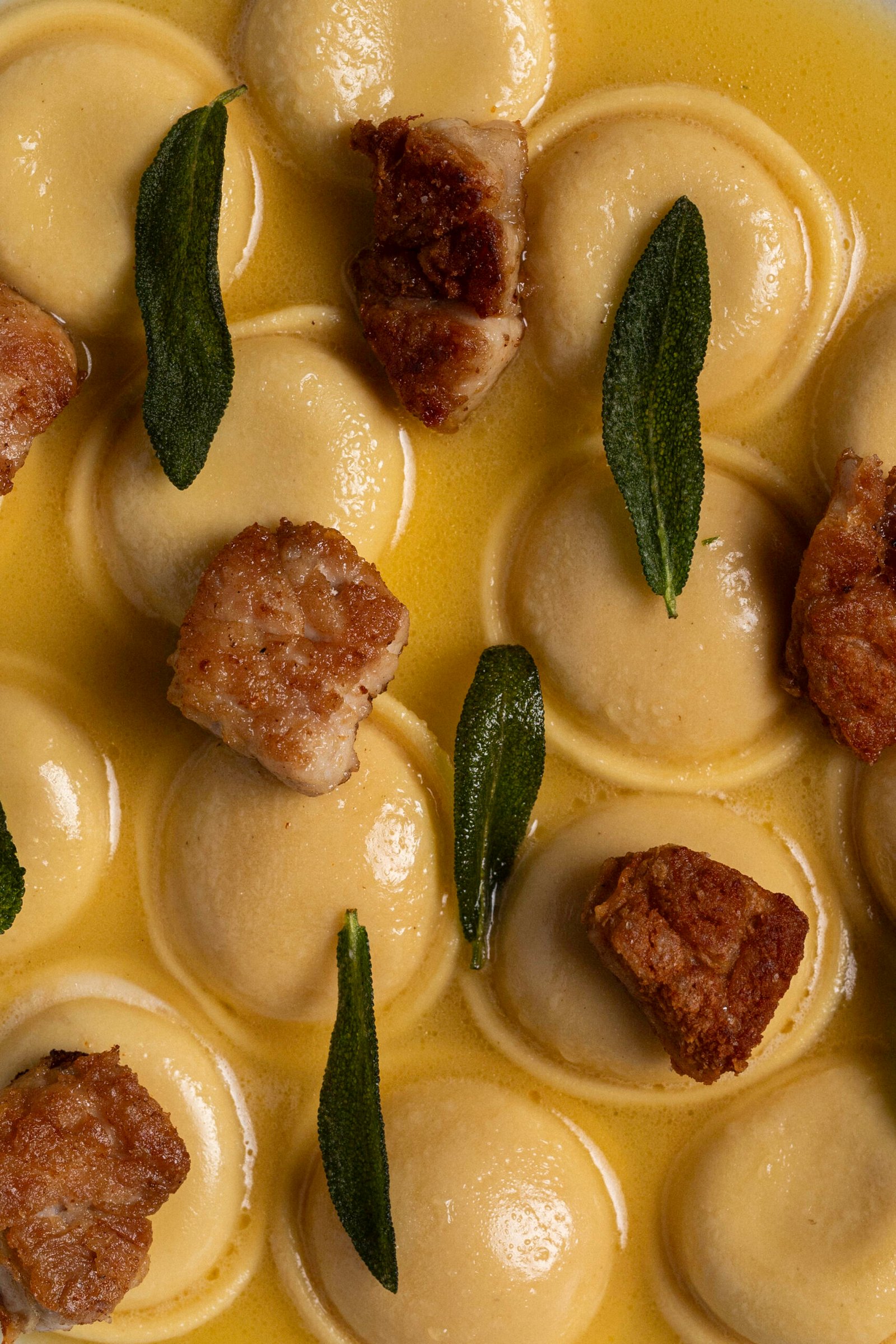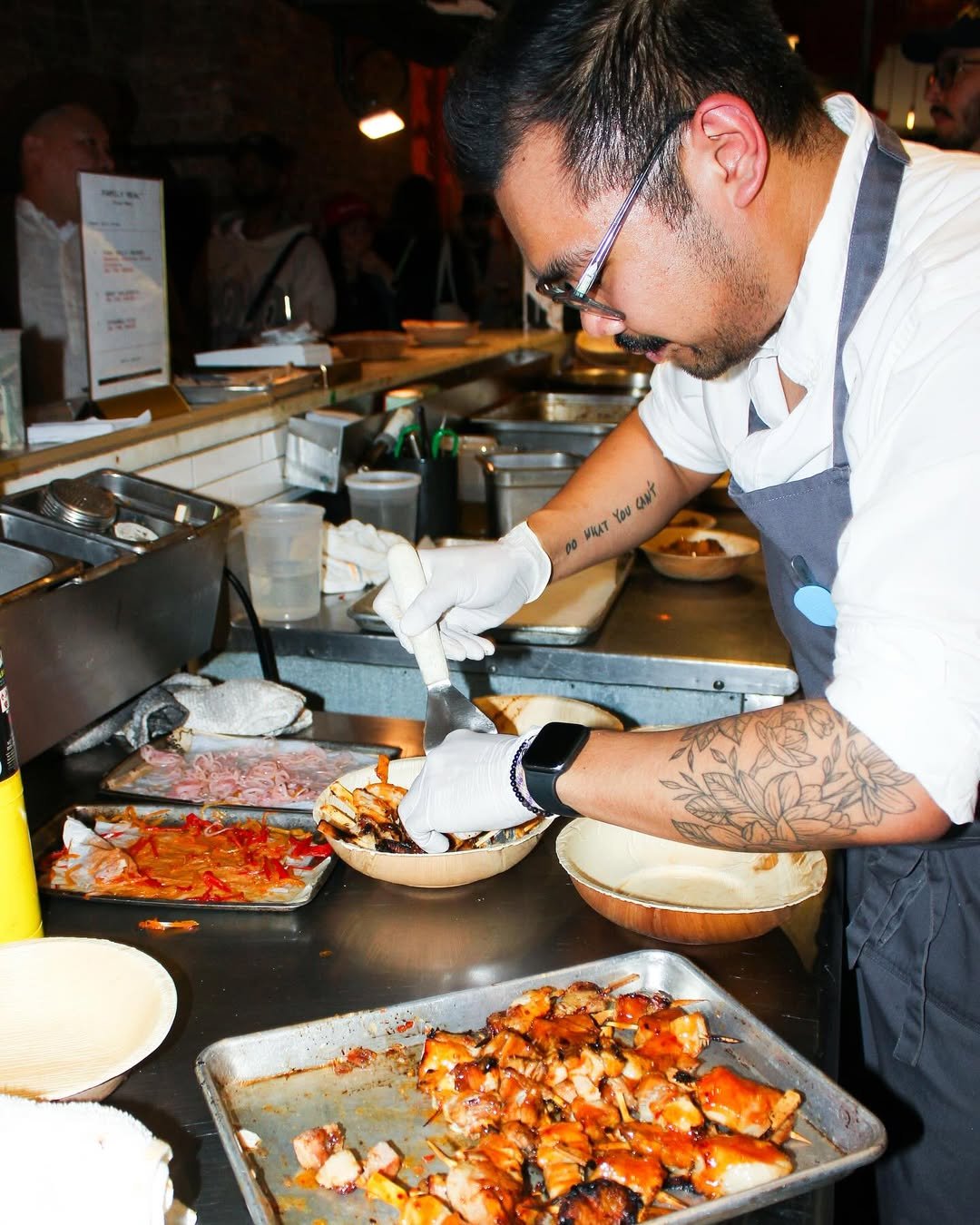A Restaurant Called Home
Humans Of The Kitchen
A story about food, family, and rewriting the recipe for how an industry should care for its own.
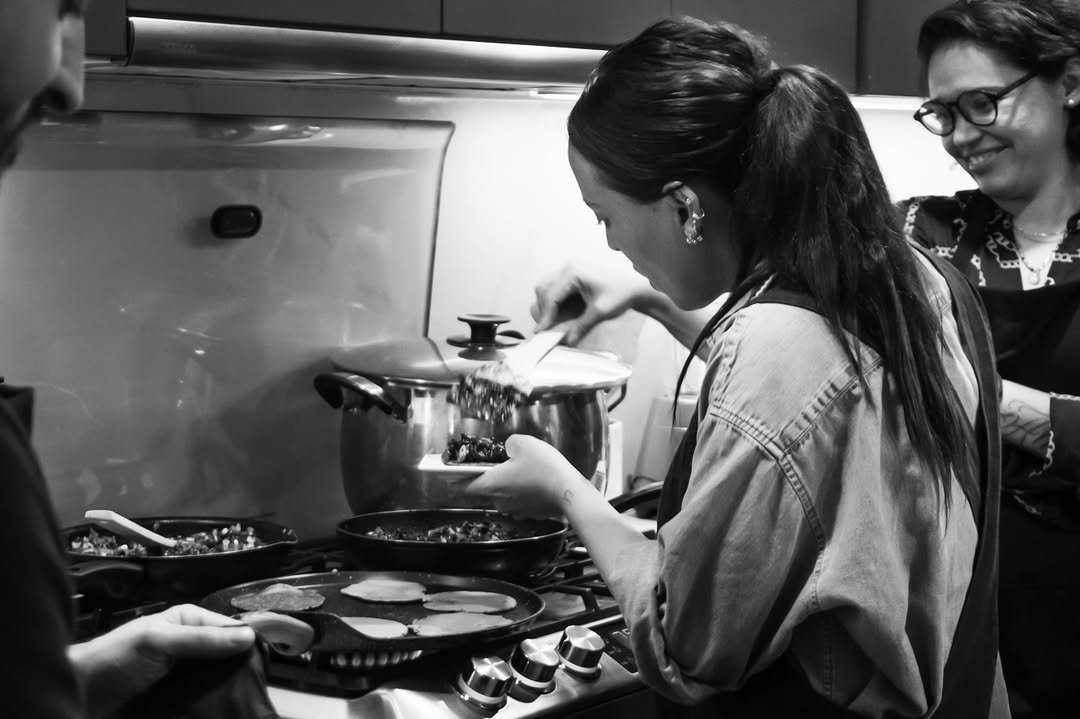
Fernanda Alvarez
I grew up surrounded by love served on plates. Sundays in my family meant endless tables, laughter, and stories, always with food at the center. My grandmother’s pots were sacred, her cooking a blend of Mexican roots with German and French touches. You could smell her dishes from the street, calling everyone home. Around that table, I learned that food was more than sustenance. It was love and belonging. That is why I chose this path, because I believe there is no greater act of love than sharing your heart, your essence, your table, and your soul in every plate you serve.
Cooking opened every door in my life. It led me into television, into creating experiences, and into founding my companies. Epic Happenings in Mexico City and Miami, and Epic Foods in CDMX. Whether I’m curating private chef services as an Airbnb partner or planning soulful corporate dinners, everything begins with cooking. It’s the foundation of who I am.
I studied culinary arts formally, but most of my education came from the kitchens of life: restaurants, catering, television sets, and the traditions passed down in my family. That blend of formal training and lived experience shaped me into a chef who values both technique and intuition.
My first taste of a restaurant kitchen was in Italy, at eighteen, when my parents and I made fresh pasta from scratch in the home of Massimo and Patricia. That moment touched my heart, showing me how food carries soul.
Later, in Mexico City, I stepped into my first professional kitchen: chaos, rhythm, giant pots, prep women who were the true queens. They carried centuries of knowledge in their hands, and I was in awe. I learned quickly that the kitchen pushes you to the edge. It humbles you, tests you, and forces you to grow.
There were times I felt too small, intimidated, and overwhelmed. At eighteen, the pressure and rhythm nearly broke me. But I learned to reinvent myself, to embrace failure with tolerance, and to understand that you never truly know it all. There is always someone to learn from. Above all, the kitchen gave me strength and the certainty that cooking is not just my craft but my way of loving and serving the world.
Some moments have shaped me forever. Like the time a man and his son came into my Miami restaurant and asked me to cook freely. I fed them with love, not knowing he was the Mayor. Later, I cooked for his family and even delivered food to his home when he was sick during the pandemic. Or the time I cooked for Billie Eilish in Mexico, asked to prepare sustainable, plant-based cuisine. Those moments reminded me of why I belong here, because food can heal, inspire, and transform.
My philosophy in the kitchen is that food is love, connection, and respect. Every ingredient carries life, and it deserves to be treated with care and gratitude. Cooking is about creating moments that bring people together and make them feel seen. As a leader, I carry that same philosophy: leading with empathy, humility, and resilience. I encourage my team to honor the process, to trust the rhythm, and always to keep creativity alive.
For me, the kitchen is not just a workplace but a sanctuary of service and learning. When I had my restaurant in Miami, it felt like home. The customers became family, and the staff was one big family too. Raquel, a woman from Guatemala who arrived early every morning to do the prep, was significant to me. She didn’t just work beside me, she cared for me. She made my overnight oats and chia pudding so I would always have breakfast ready, and when someone in the restaurant served me food, it felt like a hug for my soul.
Everywhere in the world, cooks take care of each other. It’s a language that needs no words. You do it because at some point, another colleague has cared for you. From helping with reservations to feeding one another in our restaurants to building real connections, that spirit of hospitality is what unites us. In my own restaurant in South Florida, I supported small entrepreneurs by inviting them to host pop-ups in my space so that they could share their craft with my community.
For me, hospitality has always been about lifting each other and creating family wherever you are. During those years in Los Angeles and Miami, my family was the one I built in the kitchen: my customers, my cooking school students, the production crews of the TV shows I worked on, and even the people who turned on their television to cook alongside me. And nothing makes me happier than being invited to a taste testing or asked for my input on a recipe.
The hardest part of this industry is not the pressure of service, but the lack of care for the people who make it possible. Long hours, low wages, and neglecting to eat or drink during service are not sustainable. I dream of a more human industry, where salaries are fair, mental and physical health matter, and cooks are valued as people, not just labor.
From my side, I actively work with local producers, honoring the land and the people behind each ingredient. I also make sure to pay fair wages and create a supportive environment for my team, because when we take care of each other, the whole system grows stronger. For me, change begins with small, conscious choices that ripple outward, building a better future for everyone at the table.
Photo credits to @roy.fajardo.photo & @mayakariana
Secret Sauce
- What’s the most unexpected ingredient you’ve ever worked with, and how did it change your perspective on cooking?
One of the most unexpected ingredients I’ve ever worked with is edible flowers. At first, I thought of them only as decoration, but once I began cooking with them, I realized they carry flavor, energy, and even healing properties. They taught me that food is medicine and storytelling. This shifted my perspective forever. Now I see every ingredient, no matter how delicate or overlooked, as powerful and deserving of respect.
- What’s your “guilty pleasure” meal?
French Fries with ketchup.
- A food trend that you hate and why?
One food trend I really dislike is over-processed “healthy” products. Foods marketed as plant-based, gluten-free, or sustainable, but actually filled with chemicals, preservatives, and ingredients that don’t truly nourish the body. For me, food should be real, alive, and connected to the earth. Cooking is about honoring ingredients in their natural state, not disguising them. Trends that prioritize aesthetics or marketing over authenticity take us further away from the true essence of food, which is to nourish, heal, and connect.
- What’s the craziest shift you’ve ever worked in the kitchen? What happened, and how did you manage to get through it?
The craziest shift I ever worked was in Miami, during a holiday weekend when we were completely overbooked. The line never stopped, tickets kept flying in, and the heat, noise, and adrenaline felt like a storm. We were short-staffed, so I jumped between stations, plating, expediting, and even running food to the tables. It was absolute chaos, but also magic, because in the middle of that pressure, the team came together like a family. We laughed, we sweated, and somehow we pulled it off.
5. What happened, and how did you manage to get through it?
What happened was pure chaos, with orders piling up, hands missing on the line, and the pressure of a full house expecting perfection. I managed to get through it by breathing, staying grounded, and focusing on one plate at a time. I leaned on my team, jumped into every role that was needed, and trusted the rhythm we created together. In the middle of the storm, I realized that kitchens are not about one person. They’re about community, resilience, and the ability to turn chaos into beauty. That night taught me that leadership means presence, adaptability, and never losing sight of love for what you do.
- What tips would you give to other cooks and chefs to help them navigate their culinary careers and find peace amid the chaos of the kitchen?
My advice to cooks and chefs is to stay grounded and true to yourself. Take inspiration from others, but never copy. Trust your gut and your own original proposal, even if it doesn’t make sense at the beginning. Take time off to nurture your creativity, because burnout is real. Go to the markets, get lost in the colors, work with vegetables, superfoods, edible flowers, and ingredients that keep food alive and joyful. Learn from the real MVPs, the prep cooks, your grandmothers, your mothers, because their knowledge is gold. Stay humble, sharpen your knives, wear colorful aprons, and remember that cooking should also be fun.
At the same time, take care of your body and mind. Always eat, rest, sleep properly, and drink water. Work with a therapist to manage adrenaline consumption and a physical therapist for your lower back, knees, and legs, because the kitchen is tough on the body. Find a sous chef who shares your taste buds, so you don’t carry the weight alone. Find your crew, the people you can trust, and take care of them as much as they take care of you. Cook as if you were cooking for yourself, because every guest is the most special guest.
And never forget that we are all rockstars. Don’t compete, make teams, and grow together. Cook alongside your favorite chefs and colleagues. Celebrate each other’s victories, because when one of us rises, we all rise.
- What’s an underrated ingredient and why?
An underrated ingredient for me is cilantro. Many people think of it only as a garnish, but it is so much more. It carries brightness, depth, and even healing properties. Cilantro can transform a dish with just a handful, bringing freshness and balance to heavy flavors.
8. What’s a must-try dish from your kitchen or the one you’re proudest to have prepared?
I don’t think I have just one favorite dish I’ve cooked, because for me it’s not about the recipe itself, but about what it creates. What excites me most is when a dish transports someone or when a flavor reminds them of their grandmother’s kitchen, a childhood Sunday, or a moment of joy they thought they had forgotten. Sometimes it’s a colorful plant-based ceviche, a reimagined mole, or even a simple dish made with love, but the common thread is that food becomes a portal. My proudest dishes are the ones that awaken memories and emotions, because that is when food goes beyond the plate and touches the soul.
About Your City!
Mexico City
- If Anthony Bourdain or a chef came to your city, what would be the perfect tour itinerary from breakfast to dinner?
If Anthony Bourdain or a chef friend came to Mexico City, I would start the morning at my home with one of my colorful superfood smoothies, before heading out to Mercado de Medellín to explore local produce, edible flowers, and spices. From there, we’d stop at Buna Coffee for the best cortado with oat milk, and then visit Mercado el 100 to meet my favorite organic farmers and small producers.
For lunch, I’d take them to what I consider the best taco food truck in town, followed by an afternoon walk through Condesa and Roma, and then a stop downtown at La Lagunilla market for antiques, music, and culture. The next morning, we’d head to the chinampas in Xochimilco at sunrise, to watch the day begin while sharing homemade tortillas and fresh local produce surrounded by history and nature. Back in the city, we’d pause for my favorite matcha and a walk with my dog. For drinks, I’d take them to Bósforo for an unforgettable mezcal experience. Then, we’d sit down for dinner at Máximo, one of my favorite restaurants in Mexico City, where modern creativity meets tradition.
And finally, we would end the night with a bike ride through the city with one of the local cycling clubs, a perfect way to feel the accurate pulse of Mexico City.
A New Generation of Chefs
Humans Of The Kitchen
Zoe’s mission is to lead with empathy, creativity, and a vision for better kitchens.
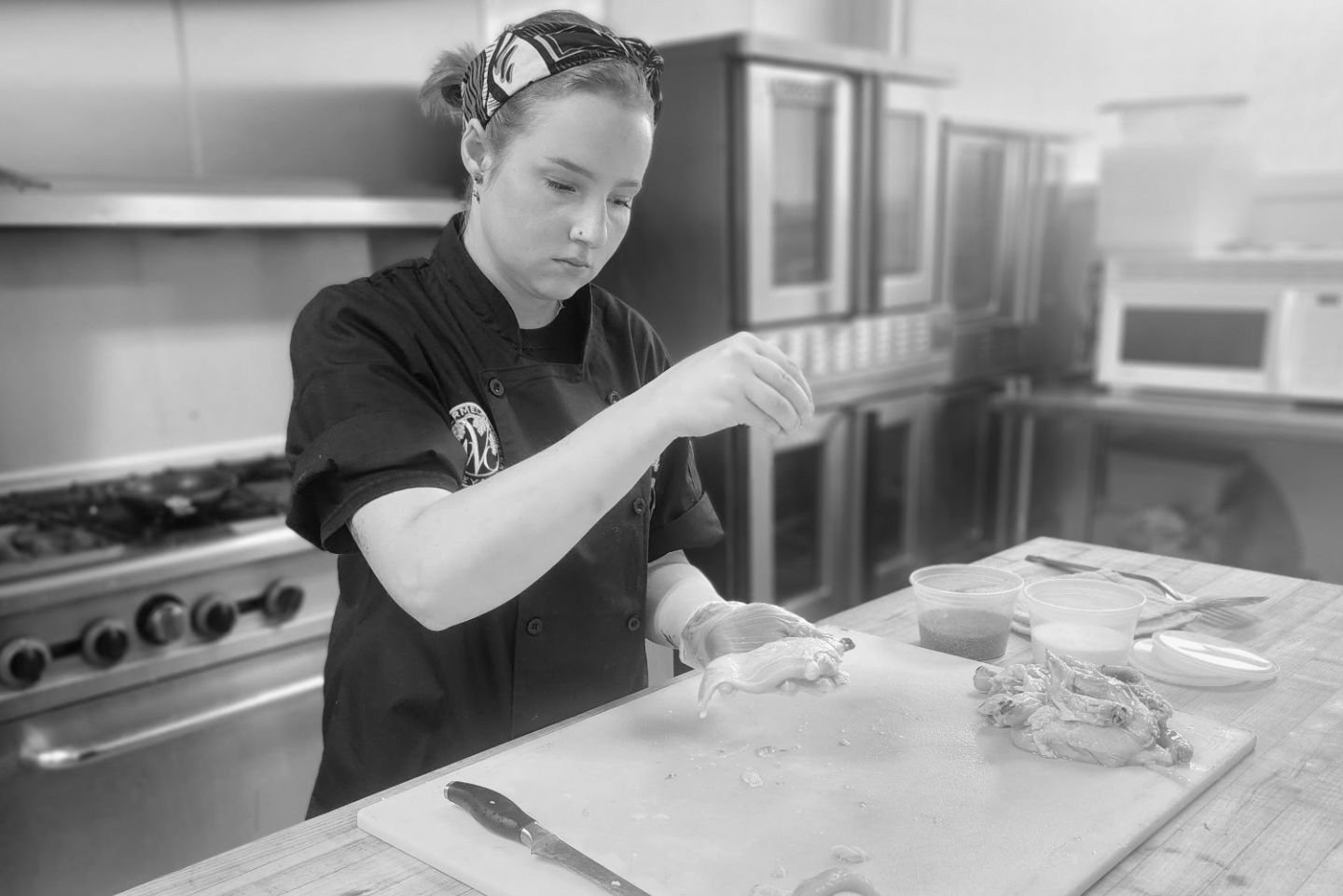
Zoe Griffee
I have countless memories from my childhood that make me reflect, “I should have known I was destined to be a chef.” From watching Rachael Ray when I was just four years old, to my obsession with Cooking Mama on my Wii, to bonding with my dad over food shows, cooking was always a part of my life. But it wasn’t until my sophomore year of high school that I decided this wasn’t just a hobby; it was going to be my career.
I’ve never worked outside of a kitchen. Less than a month after graduating high school, I enrolled in culinary school in the middle of the pandemic. My first semester began with eight students, and by the third, it was just me and one other. In the end, I was the only one to graduate. That moment gave me confidence, but it also came with pressure. Moving up quickly meant learning lessons the hard way about leadership, self-discipline, and respect.
My first kitchen job was at Soyumi, a fast-casual Asian-American spot. I learned the fry station, wok, grill, expo, all of it. But nothing was made from scratch, and I wanted more. I found Sugar Magnolia, a small bistro that transformed into a high-end dinner spot at night, and applied right away. At 19, I walked in, terrified, surrounded by chefs in their 30s. I almost got fired within two months because I couldn’t keep up, but my chef saw something in me and gave me a chance. That place broke me down, humbled me, and pushed me harder than I thought possible. Eventually, I became sous chef, but that came with managing a team, so their mistakes became my mistakes. I wasn’t ready, and without guidance, it weighed on me.
When I left, I almost gave up on cooking altogether. The toxicity I experienced had me questioning if I even belonged in this industry. But taking the position at Watermelon Creek Vineyard changed everything. Running my own kitchen forced me to face my doubts head-on and reconnect with why I love cooking: the craft, the ingredients, the quiet rhythm of creating something that matters.
The moments that stay with me most aren’t the promotions or the positions. It’s when a guest tells me it’s the best meal they’ve ever had. That’s why I do this. Food isn’t just about nourishment. It’s connection, memory, and joy. I put my whole heart into every plate, hoping to make someone’s day better.
I’ve seen the darker side of the industry. The normalization of drugs and alcohol, the expectation to push yourself until you break. I don’t buy into that. Addiction is real, but I believe the culture around it doesn’t have to make it worse. I want to be part of a generation of chefs who create healthier kitchens, where respect and growth take priority over burnout.
My philosophy is simple: respect. Respect for ingredients, respect for the craft, and respect for the people in the kitchen with me. I believe in consistency, in intention, and in leading by example. Kitchens can be brutal places, but they can also be spaces of laughter, honesty, and camaraderie. That’s the culture I want to build.
Culinary school taught me determination. Becoming sous chef at 19 proved that I could hold my ground. But what keeps me inspired, even now, is the freedom to create and the support of those who believe in me. My biggest inspiration has always been my dad. He’s the one who first pulled me into the kitchen, the one I bonded with over food, the one who lit this fire in me. I wouldn’t be here without him, and every plate I send out carries a little piece of that story.
Secret Sauce
- What’s the most unexpected ingredient you’ve ever worked with, and how did it change your perspective on cooking?
One of my biggest surprises in cooking was discovering how much I enjoy meat fabrication. Breaking down a whole fish or a primal cut of meat connects me to the bigger picture: The animal, the anatomy, and the respect for what we’re given to cook with.
- What’s your “guilty pleasure” meal?
Frozen burritos.
- A food trend that you hate and why?
Butter candles. Just eat butter like a normal person.
- What’s the craziest shift you’ve ever worked in the kitchen? What happened, and how did you manage to get through it?
I’ll never forget when a coworker once sliced his hand badly while cutting scallions.
5. What happened, and how did you manage to get through it?
He was bleeding on the floor while yelling at me to pour bleach on it. A few minutes later, he went pale, sat down, and fainted. That was the first time I had ever seen someone pass out, and it shook me, but in the kitchen, you just have to keep going.
- What tips would you give to other cooks and chefs to help them navigate their culinary careers and find peace amid the chaos of the kitchen?
When I get discouraged, I remind myself that everything is a learning experience. Every setback makes you stronger, and every success shows you what’s possible.
- What’s an underrated ingredient and why?
Maple Syrup. It is my favorite sweetener for sauces and a pairing for cheese.
8. What’s a must-try dish from your kitchen or the one you’re proudest to have prepared?
My Korean Duck a L’orange with an orange gochujang glaze, kimchi, and kombu risotto.
About Your City!
Statesboro, Ga
- If Anthony Bourdain or a chef came to your city, what would be the perfect tour itinerary from breakfast to dinner?
If you ever come to Statesboro, GA, I’d take you on a food tour. For breakfast, we’d go to Loc’s Chicken and Waffles, hands down my favorite breakfast spot in town. For lunch, visit Soon’s Döner Kebab, where the owner serves authentic Greek-style gyros made with lamb, beef, or chicken. And for dinner, Del Sur Taqueria and Cantina. Their Tex-Mex dishes are fresh and delicious, but my go-to is their poke bowl.
Never Too Late for the Language of Food
Humans Of The Kitchen
When the page ran out of words, the kitchen became the next chapter.
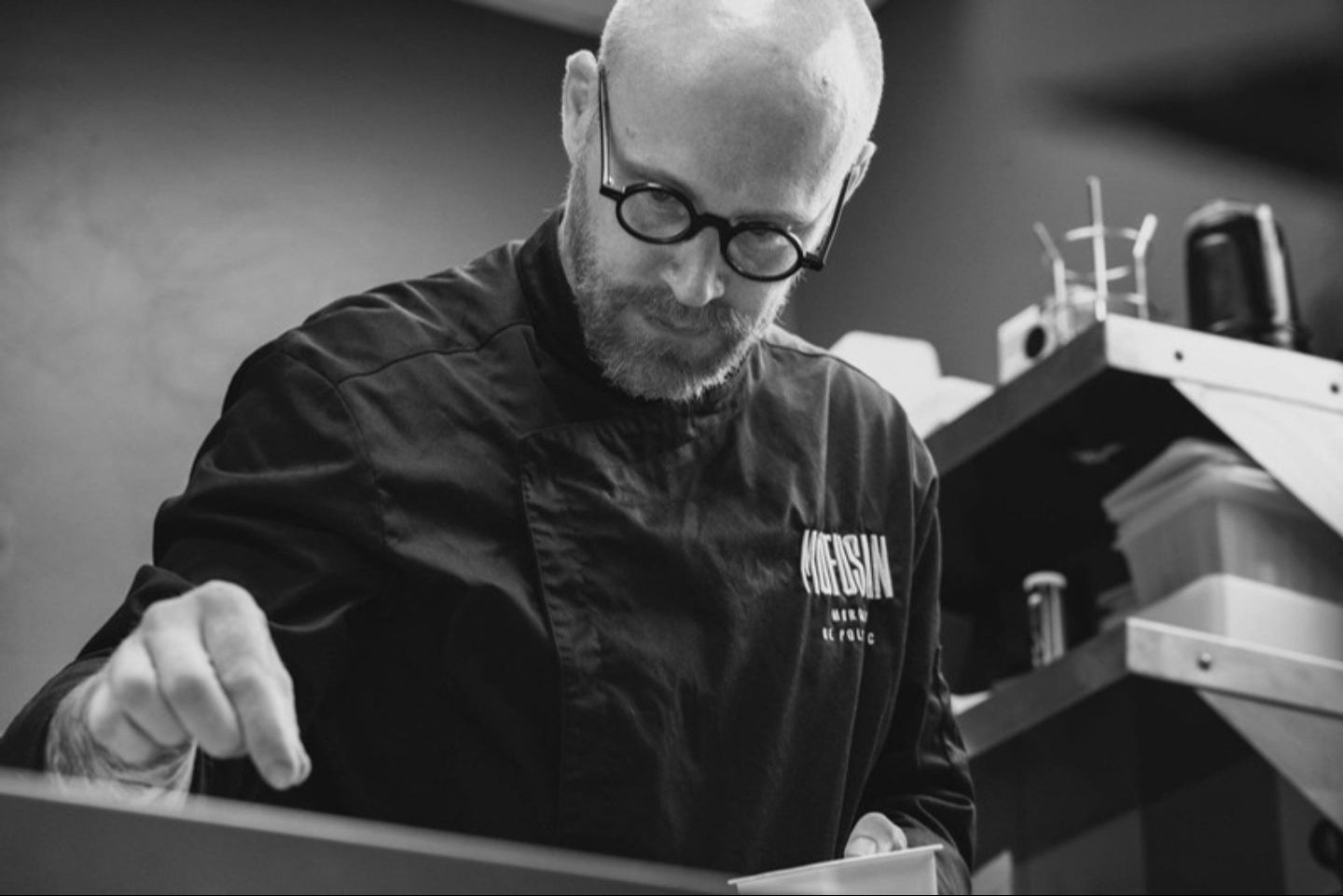
Morgan de Polignac
My path to the kitchen wasn’t straightforward. For more than a decade, I taught Chinese literature after completing a PhD. I loved it, but around thirty-five, I felt a void, a sense that I needed to try something else before it was too late. That’s when I stepped into a small, traditional restaurant kitchen in Lyon for the first time. The rhythm was brutal, I had no technique, and I was juggling garde-manger and pastry. But it taught me the essentials: discipline, mise en place, and how to breathe under pressure.
The spark, though, began much earlier. As a child, I watched a family friend arrive on Sundays with bags of groceries. She would cook for us, letting me taste everything, teaching me the foundations of classic French cuisine. It felt like having another grandmother, and it planted the seed of a passion that never left me.
I studied basic culinary arts, a six-month training program, and then transitioned directly into the field. Since then, my path has been shaped by the people I’ve met. A pastry chef who had worked for a decade in a three-star restaurant showed me that pastry was not just recipes, but harmony, pairing, and endless curiosity. Another mentor reminded me, at a moment when I nearly quit, “Don’t overthink it, just do it. If it works, continue. If it doesn’t, start again.” Those words still guide me.
For me, the kitchen is a place of creation and exchange, a tool to mold ideas, but also a space to share knowledge and build together. Transmission is vital. I’ve almost walked away from this world several times, but each time, passion pulls me back. Cooking without sharing has no purpose.
The proudest moment of my career has been opening my own restaurant, @mofusan_lyon. Seeing people happy, receiving excellent reviews, and creating a space where young cooks want to learn, that recognition means more than any title. Teaching occasionally at culinary schools, passing on techniques, feels like a responsibility, but also a gift.
I have been cooking for ten years, and during this time, I have met many wonderful people, as well as some who were not so great. Nevertheless, it has been an enriching journey that has taught me so much about humanity, sharing, teaching, and learning. Everything is intense and concentrated all the time, and it never ends. The best reward I can receive is seeing someone enjoy one of my meals.
What I want for the future of this industry is transparency, humility, and true collaboration. Less ego, more openness. More chefs are stepping out of the kitchen to connect with the people they cook for. Because food is not just nourishment, it’s a conversation. And for me, every plate is an invitation to share.
Photo credits to @mchlm.photo
Secret Sauce
- What’s the most unexpected ingredient you’ve ever worked with, and how did it change your perspective on cooking?
The first time I used eggplant in a dessert. It was a silly challenge launched by my head chef, which resulted in an excellent outcome. After a lot of thought, I’ve come to realise that cooking has no boundaries.
- What’s your “guilty pleasure” meal?
Pralinés of any sort, and a good big “boudin” (pork blood sausage), eaten in the morning when I was in the countryside.
- A food trend that you hate and why?
All visual stuff that totally neglects the taste. Visuals are an introduction, but taste is the most important.
- What’s the craziest shift you’ve ever worked in the kitchen? What happened, and how did you manage to get through it?
Probably a 50-hour non-stop. I didn’t really notice what was around me much. And in the end, I started hallucinating, seeing people that didn’t exist and chatting with them. Never again.
5. What happened, and how did you manage to get through it?
I just did it, focusing on tasks to be completed and avoiding overthinking.
- What tips would you give to other cooks and chefs to help them navigate their culinary careers and find peace amid the chaos of the kitchen?
Working your best, always be in the position of learning, and working on self-organisation, always trying to improve yourself. Talk freely and honestly, and if you encounter bad or evil people, just leave.
- What’s an underrated ingredient and why?
Veggies in deserts. There is a lot to explore!
8. What’s a must-try dish from your kitchen or the one you’re proudest to have prepared?
Probably eggplant in a desert. Matched with hojicha, bay leaf, cardamom, and honey.
About Your City!
Lyon, France
- If Anthony Bourdain or a chef came to your city, what would be the perfect tour itinerary from breakfast to dinner?
That would be the “Halles Paul Bocuse”, the groceries markets along the river, a lunch in a traditional restaurant we call “bouchon” in the old city “Vieux Lyon”, an afternoon in a coffee shop enjoying the river bank, and a diner in a restaurant in Fourvière (a hill, from which you can see the whole city).
Brown Butter Dreams
Humans Of The Kitchen
A chef’s mission to craft a human-sustainable kitchen culture, where precision meets purpose, and community comes first.
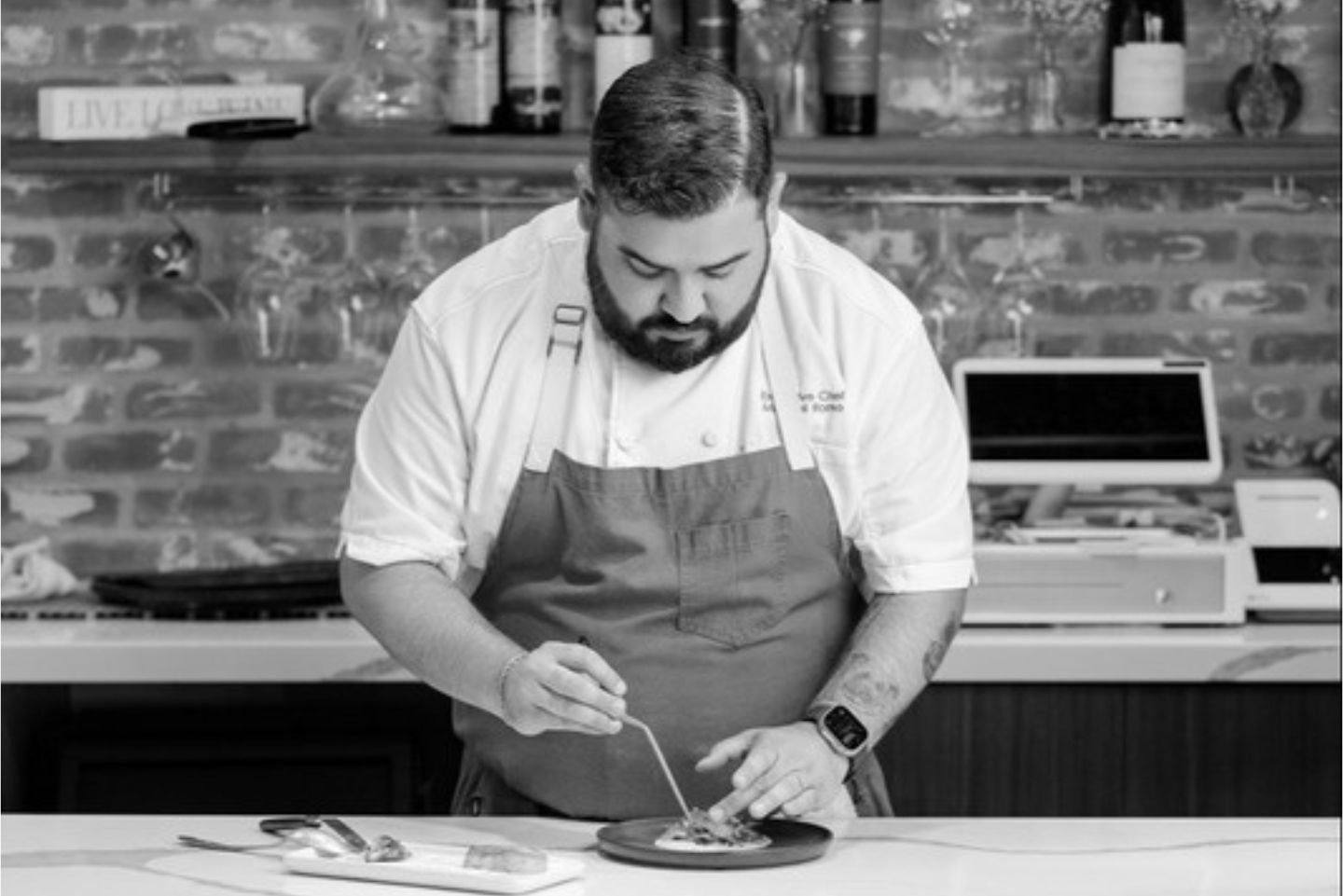
Michael Romo
I grew up in Long Beach, the child of first-generation immigrants, and much of my early upbringing was entrusted to my grandmother, who traveled from Aguascalientes, Mexico, to raise me. Some of my most formative memories are at eye level with the kitchen table, watching her hands work with rhythm and intention. The way fresh masa transformed under her touch was mesmerizing, humble ingredients becoming both nourishment and celebration. That table became my first classroom, where food revealed itself not only as sustenance, but as love, culture, and community. Those early lessons continue to shape the tables I create today.
At 17, I began as a dishwasher and worked my way through each station, discovering discipline, rhythm, and purpose along the way. By the age of 24, I became the Executive Chef of 320 Main in Seal Beach, a restaurant highly esteemed by my mentors. I never pursued another career. Cooking was always the path. For a short time, I enrolled in culinary school, but when I learned I was expecting my daughter, I left after a month and chose the kitchens as my classrooms instead. Every plate since then has been intentional: grounded in discipline, adaptability, and the responsibility of fatherhood. Food has never been just a technique for me. It’s been about creating a future, honoring sacrifice, and feeding the community.
I still remember my first time on the line, assisting Chef Andrew Gruel at an event at the Aquarium of the Pacific. The line moved like a dance, silent communication, urgency, precision, not a movement wasted. That rhythm shaped how I move in kitchens to this day. In those early years, the most significant challenges were endurance and balance. I was a young father, working 12+ hour shifts, sacrificing time at home with my newborn. The kitchen became my teacher: pushing me to listen more than I spoke, to move with intention, to adapt quickly. Over time, what once felt impossible became second nature.
Community has always been my anchor. What sustains me, even in the hardest days, is knowing that food is more than a meal; it’s belonging. After years of pursuing French and Italian techniques, one of my mentors, Luisteen González, reminded me to delve deeper into my own heritage. He told me that what I carried in my veins and on my palate couldn’t be bought, replicated, or taught; it had been passed down through the eternal love of my grandmother. That conversation reshaped everything. Today, my food honors those roots while incorporating techniques and flavors from around the world.
My philosophy in the kitchen is rooted in intention, community, and accountability. As Maya Angelou said, “People will forget what you said, people will forget what you did, but people will never forget how you made them feel.” A strong kitchen, like a strong team, is built on trust, humility, and the willingness to surrender the “me” for the “we.” As a leader, I strive to elevate those around me, teaching that discipline and resilience matter, but so do empathy and collaboration. Success is not an accident; it is a result of sacrifice, perseverance, and love for the craft.
Kitchens have given me both craft and family. Long before I had the means to host birthdays or holidays at home, I would share them with staff over meals or on the line. In hard times, that camaraderie reminded me I was never alone, that the bonds forged in heat and pressure can carry you through life’s most difficult seasons.
I’m proud of how far those bonds, that discipline, and that community have taken me. From winning the “Best Steak” award at Chianina Steakhouse to becoming the youngest Executive Chef at Puesto, and from seeing The Brown Butter Boys featured in LB908 Magazine, each milestone has been proof that the impossible becomes possible with resilience and community behind you.
The Brown Butter Boys Supper Club was founded in 2021 as a response to the barriers I observed within the fine dining industry. After years in acclaimed kitchens, it was clear there was a gap between the artistry of cuisine and the accessibility of the experience. We set out to bridge that gap with nine-course hyperseasonal dinners offered at an approachable price, hosted in rotating intimate spaces across Long Beach and beyond. The response was immediate: our first year sold out in two months, and every dinner since then has sold out rapidly. Our guiding principle remains simple and straightforward: for the community, by the community.
What I love most about this industry is the connections I have with guests, farmers, and cooks who become like family. What I find frustrating is the culture of unsustainability that still persists: burnout, toxicity, and environments that prioritize sacrifice over support. With The Brown Butter Boys, I’m building a different kind of model, one that prioritizes freedom, creativity, and joy, proving that hospitality can thrive without sacrificing people.
For me, cooking has always been more than food. It’s about creating spaces where people slow down, connect, and feel cared for. My food reflects both fine-dining training and the comfort flavors of home. The Brown Butter Boys Supper Club bridges those worlds, offering experiences that honor our community while challenging me to grow as a chef. At every table, I carry the spirit of Long Beach with me.
📸 Photo credits to @nadine.photo.art
Location: @wineon2nd
Secret Sauce
- What’s the most unexpected ingredient you’ve ever worked with, and how did it change your perspective on cooking?
The most unexpected ingredient I’ve ever worked with was the chicatana ant, a delicacy in parts of Mexico. At first, it didn’t feel very safe, something so outside the realm of everyday cooking. But working with it shifted my perspective: it reminded me that ingredients carry stories, history, and identity. The smoky, nutty intensity of the ants deepened my respect for indigenous foodways and for looking beyond the familiar. It taught me that inspiration doesn’t always come from luxury ingredients, but often from what’s been preserved and celebrated by generations before us.
- What’s your “guilty pleasure” meal?
Fried eggs, salsa macha, and warm corn tortillas.
- A food trend that you hate and why?
The food trend I dislike most is wastefulness; dishes built more for spectacle than for eating. Ingredients and resources are too valuable to treat as disposable. We can do better by cooking and serving food that nourishes, honors, and still looks excellent, sustainably.
- What’s the craziest shift you’ve ever worked in the kitchen? What happened, and how did you manage to get through it?
The craziest shift I’ve ever worked was the debut brunch at a Mina Group restaurant, when every water hose on the back line burst at once. We cooked in two inches of water, tickets never stopped, and neither did we. It proved that kitchens survive on grit, teamwork, and adapting under pressure.
5. What happened, and how did you manage to get through it?
To this day, no one knows why or how it happened. What got us through was sheer determination and respect for the craft.
- What tips would you give to other cooks and chefs to help them navigate their culinary careers and find peace amid the chaos of the kitchen?
“You can’t stop the waves, but you can learn how to surf.” – Jon Kabat-Zinn.
- What’s an underrated ingredient and why?
Epazote. It’s often dismissed as a weed, but in Mexican cooking, it’s indispensable. Its sharp, pungent aroma transforms a simple pot of beans into something layered and alive. For me, epazote represents how flavor and meaning can come from the most overlooked places. It’s a reminder to honor what tradition has preserved for generations, and to see value where others might not.
8. What’s a must-try dish from your kitchen or the one you’re proudest to have prepared?
A must-try dish would be Binchotan-grilled white asparagus. The asparagus is gently poached and compressed with Japanese smoked vinegar, then charred over Binchotan charcoal and finished with a miso glaze. It’s served over a classic soubise with a coddled egg, fried shallots/leeks, and chervil. For me, it represents the way I approach food: rooted in technique, respectful of seasonality, and unafraid to create something expressive. Every element has intention, yet the dish feels simple in the moment, proof that discipline and restraint can create both harmony and surprise on a plate.
About Your City!
Seal Beach
- If Anthony Bourdain or a chef came to your city, what would be the perfect tour itinerary from breakfast to dinner?
Born and raised in Long Beach and now in Seal Beach, the tour starts at Catrina Café for chilaquiles, the kind of plate that makes my uncle fly in from CDMX and demand it every time.
Lunch? Sushi Ryokan, a strip-mall joint where Panda runs the bar with a smile, is proof that some of the best bites hide in the least flashy corners. Then a greasy, perfect burger at Fantastics on Cherry and Wardlow, no frills, just soul.
Dinner kicks off in Bixby Knolls with cocktails, chips, and dangerously addictive salsa at Lola’s, before ending the night shoulder-to-shoulder at Los Compadres over a molten molcajete, queso fundido, and fresh tortillas. That’s Long Beach, rough around the edges, but unforgettable at the table.
Cooking for More Than Himself
Humans Of The Kitchen
How becoming a young father pushed Egypt to turn passion into purpose.
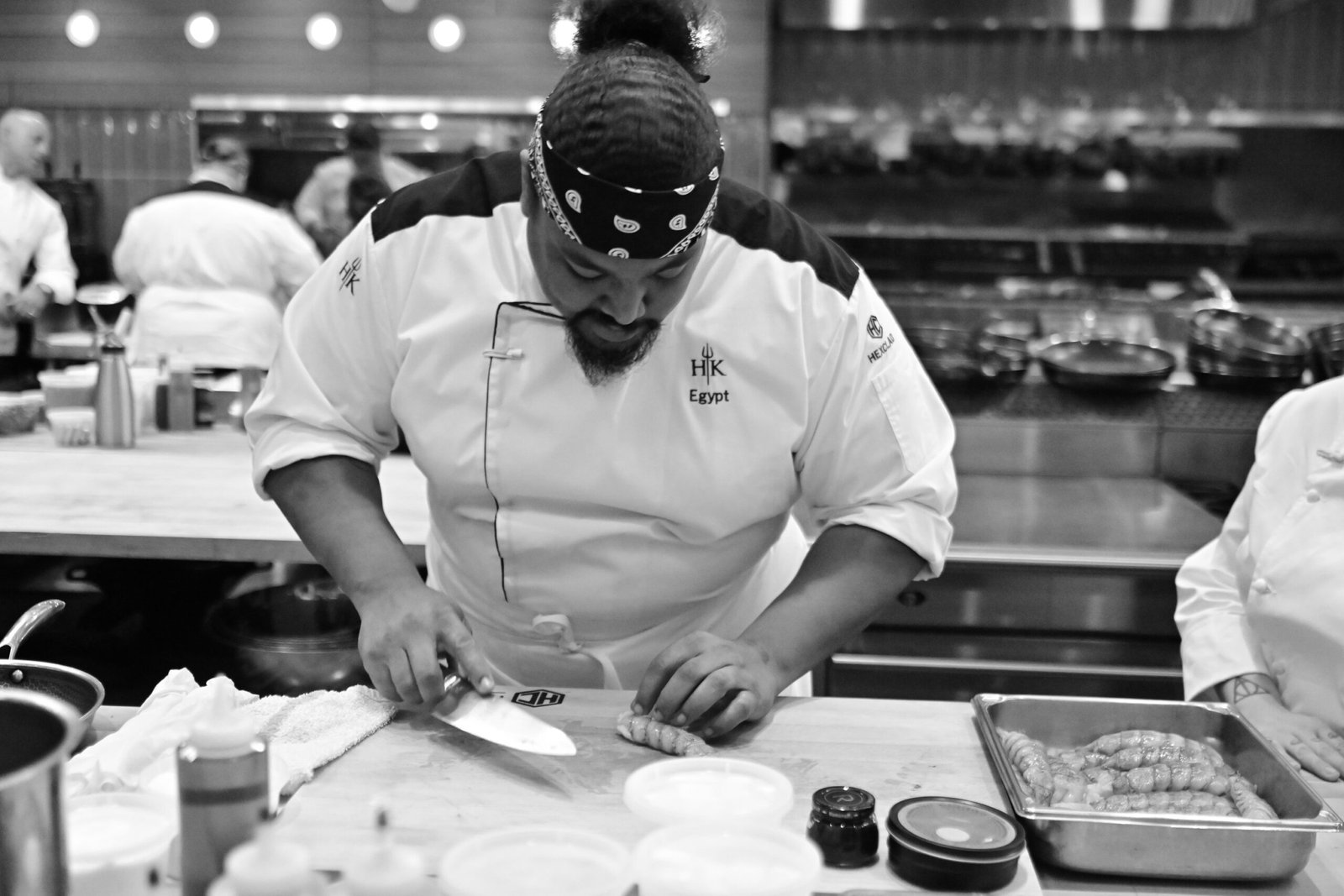
Egypt Davis
For most of my childhood life, we were very poor and couldn’t eat most days as we were on the streets and in and out of shelters. In 4th grade, my class had a “Pot-Luck”. Since we didn’t have much, my mom “borrowed” some rice, tomatoes, and spices from work to make Spanish Dirty Rice. She let me help her. All I did was smash tomatoes and mix in the rice, and as corny as it sounds, when I was stirring the rice into the tomatoes there was a literal spark in my heart. The next day, when I saw the smiles of my classmates reacting to the simple rice we made, I knew I wanted to cook.
I enrolled in culinary school right after high school, paying out of pocket. But tuition kept rising, and I couldn’t keep up. I dropped out. The next day, I walked into ACF certified Master Chef, Edward Leonard, restaurant looking for a job. I told him I wanted to learn from him regardless of being paid. His response was to burst out laughing in my face and then say “If you dedicate your life to me, I’ll dedicate my time to you and make you something great.”
He hired me and made me a Master Chef’s Apprentice. For the next six and a half years, I trained under him, learning, traveling, absorbing everything I could. I studied under other Master Chefs, built a foundation in technique, and honed my philosophy: stay fluid, continually learn, and cook like your family is at the table.
After becoming a father early, I was determined to give my daughter a better childhood than mine and improve life for my mom and siblings. My love for cooking became my way to provide for them. Whenever I face challenges in the kitchen, I draw strength from my family to find my inspiration again.
That drive has taken me places I never imagined, like placing third in Hell’s Kitchen: Head Chefs Only season 23. Competing at that level validated everything I’ve worked for.
One of the biggest problems in this industry is waste. That’s why I started a food donation project in Palm Beach County, working with local kitchens to rescue safe, unsold food and distribute meals to those in need. I also hope to see more fusion as the industry evolves. Food is a universal language, but chefs often stay locked in their traditions.
Working and living in the restaurant world comes with its highs and lows, but for me the best part is that no matter how far you go, there’s always something new to learn. I believe there’s knowledge to gain from everyone, and that belief fuels my approach in the kitchen: stay fluid.
Growing up with little to eat made every bite feel special, even a simple salted tortilla was mind-blowing to me as a child. Now, as a chef, discovering how vast food can be fills me with excitement and keeps me inspired to grow.
Photo 2, 4, & 6 taken by @chef_el.fuego
Secret Sauce
- What’s the most unexpected ingredient you’ve ever worked with, and how did it change your perspective on cooking?
The most unexpected ingredient I’ve had the pleasure of working with was Kangaroo and Camel Meat. During my apprenticeship days, I was introduced to two extremely gamey meats. At first, the flavor and smell put me off using them, but now I can push the boundaries of my recipes by changing the common proteins for game proteins, elevating many of the dishes I create today.
- What’s your “guilty pleasure” meal?
My Guilty Pleasure meal is Southern Style Fried Chicken smothered in Buttermilk Sausage Gravy.
- A food trend that you hate and why?
I genuinely love all the trends that show the development of the culinary world.
- What’s the craziest shift you’ve ever worked in the kitchen? What happened, and how did you manage to get through it?
When I first started my apprenticeship, I worked for 3 months straight with no days off. We lived at the restaurant, starting as early as 5:30 am and continuing until 1 am.
5. What happened, and how did you manage to get through it?
My mentor was and still is exceptionally passionate about all things culinary and tends to get swept away in his projects. When I became his underling, he warned me of this. So I was prepared before going into it.
- What tips would you give to other cooks and chefs to help them navigate their culinary careers and find peace amid the chaos of the kitchen?
Learn to accept, breakdown, and absorb criticism and then use that information to grow. Also, never believe that you know it all, knowledge comes from listening and understanding, there are different ways to reach the same destination.
- What’s an underrated ingredient and why?
Black Garlic. Most chefs I have come across have never heard of Fermented Garlic, and those who typically don’t like it because of the strong, unique flavor. But I personally love it.
8. What’s a must-try dish from your kitchen or the one you’re proudest to have prepared?
My southern style Mac-n-Cheese and “Collard” Green Beans (Green Beans done Collard Green Style)
About Your City!
Chicago
- If Anthony Bourdain or a chef came to your city, what would be the perfect tour itinerary from breakfast to dinner?
- For Breakfast, we would eat at The Original Pancake House in Hyde Park, Chicago.
- For lunch, we will go to Los Comales in Pilsen, Chicago. (Mexican Cuisine).
- For Dinner, we would go to Flat Top Grill in the heart of Downtown Chicago.
- Recommended Places in your city:
- Dish or food you must try: Italian Beefs-Dipped, Mozzarella, Giardiniera
- Cultural Events: Taste of Chicago
- Neighborhoods: Pilsen and Little Village
- Street Food/Food Trucks: The Elotaro’s on the corners in Pilsen.
- Restaurants: Flat Top Grill and Uno Pizzeria
- Bars: Timothy O’Toole (Gold Coast Downtown Chicago)
The Strength of Women, the Flavor of Manabí
Humans Of The Kitchen
From an ancestral oven to leading kitchens and building a network that preserves memory and fuels the future.
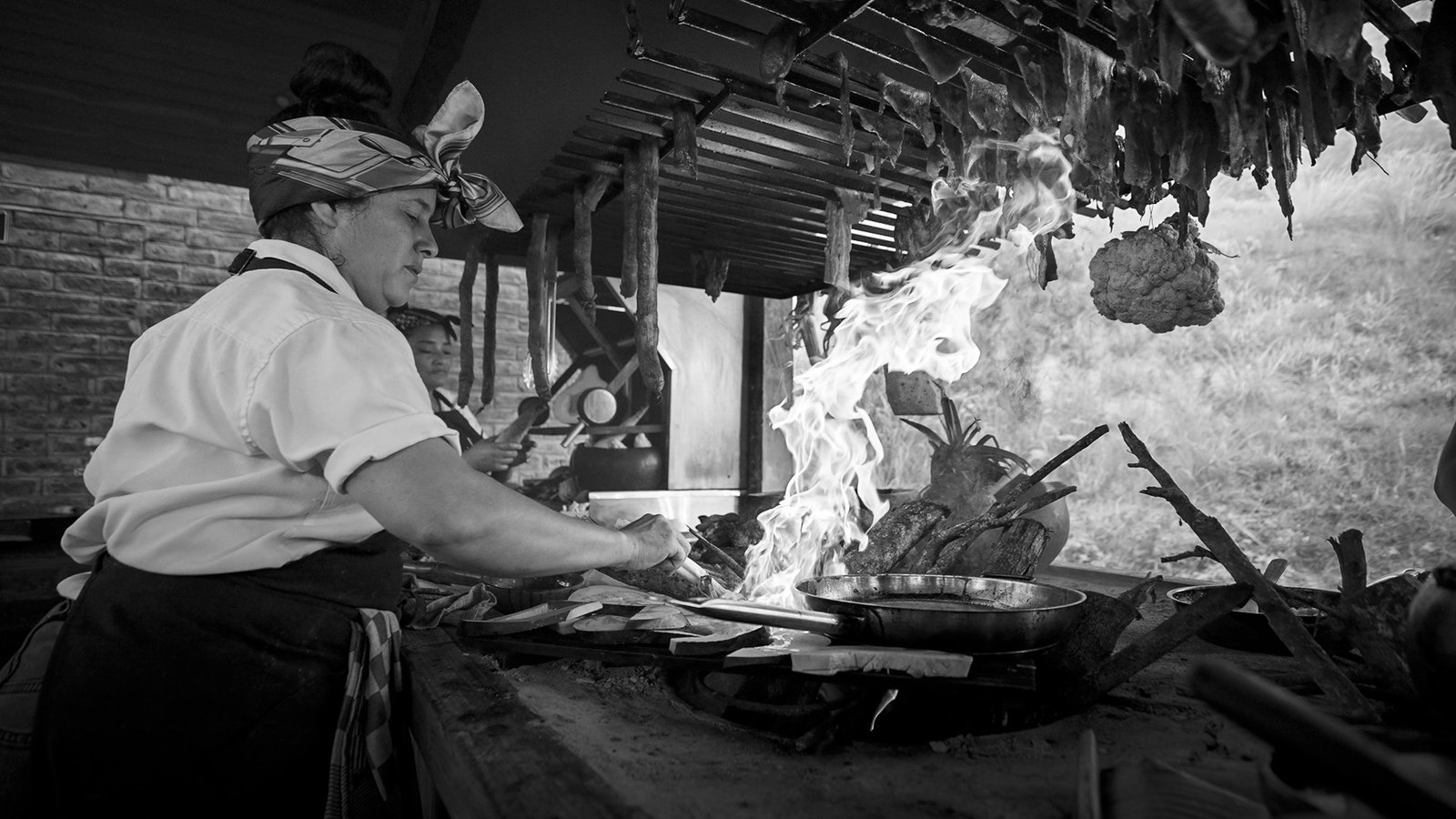
Laura Valentina Alvarez Solórzano
I was raised beside a manabita oven, a space alive with tradition and ancestral memory. My earliest years were spent with my great-grandmother, Dona, watching the magic move through her hands as flavors rose from the fire. The smells clung to my skin, the smoke filled my eyes, and my soul bonded with the land. For me, cooking has always been more than work. It is ritual, song, and sharing. I cannot imagine myself doing anything else but cooking, learning from other women, and building a better future for my community through our identity and food.
Though I always loved cooking, I also studied a master’s in gastronomic education because teaching is part of who I am. Today, I work with @icherestaurante, a project that was born to rebuild and regenerate Manabí after the devastating earthquake of April 16. At its core, it is food with purpose, and that mission continues to guide me.
I am a traditional cook. My training began at home, at the fire, and with the women of my family and community. Every flavor, every bite, was a lesson. Cooking provided us with the income to survive, helped us send our children to school, and remained an integral part of my path, even after marriage, when I began working in the restaurant of my husband’s family. That kitchen became my school, a space of trial and error, laughter and resilience, where I grew by doing, guided by the queens of the fire.
My first restaurant experience came when I took over an abandoned kitchen in my mother-in-law’s hotel. With only my own resources and knowledge, I transformed the space, learning alongside women from the community. Later, in 2019, I applied for the sous chef position at @icherestaurante. At first, I didn’t think I belonged, surrounded by candidates with Michelin-star backgrounds; I felt like “just a simple cook.” But my friends pushed me forward, and I was chosen. They saw what mattered most: my knowledge, passion, ancestral connection, and identity.
Those early years weren’t easy. I struggled to learn the language of a professional kitchen, and many times I cried alone. People doubted me, some even mistook me for a student instead of a chef. But I defended my culture, my technique, and my flavors, and they spoke louder than words. Our first menu embodied everything about me.
What keeps me inspired is the women’s community: the fire, the farms, the joy of creation. Together, we fight for recognition, for our values, and for a future where our traditions live on. One moment that will stay with me forever was during the earthquake, when we cooked day and night for firefighters and rescue workers. Another was when I first raised my voice to demand respect in the kitchen. From that day on, my boss began calling me chef.
My philosophy is rooted in democratic leadership. I believe in giving people the tools and responsibilities to rise and become the best version of themselves. I don’t monopolize knowledge or authority; I share it so that my team can shine. Cooking may be heavy at times, but in the kitchen, I have found the most loyal friends, people who never leave you alone, who share joy, tears, and purpose.
Among the milestones I am most proud of is being recognized as one of the leading traditional cooks of Manabí and being invited to an important congress such as Féminas 2023. But what matters most to me is the trust and respect I’ve earned from other traditional cooks, producers, and friends, people who recognize my knowledge and passion.
I love the community culture of restaurants: the open conversations, mutual respect, and generosity. What I reject is the envy, the showmanship, and the people who try to harm others for their own satisfaction. That is why we created the Red de Cocineras Manabitas, an incredible network of women working together to raise our traditions to the highest respect and to pass them on to future generations.
For me, the future is regenerative food systems, going beyond sustainability to create justice for local people. Food should bring joy, rebuild bridges, and make us better, more human. That is the path I walk every day: food as memory, food as identity, food as a way to dream of a brighter future for all.
Photo Credits Laura’s Story
Photo 1: Club Remiun, Photo 2: Rodrigo Rojas, Photo 3: Liss Betancourt, Photo 4: Rodrigo Rojas, Photo 5: Nat Geo Festival, Photo 6: Yeiko Moreira, Photo 7: Rodrigo Rojas, Photo 8: Manabí Produce, Photo 9: Rodrigo Rojas, Photo 10: Karen Toro.
Secret Sauce
- What’s the most unexpected ingredient you’ve ever worked with, and how did it change your perspective on cooking?
The neapia. It is a paste made for the mandioca milk, and it has a fantastic flavor, full of umami
- What’s your “guilty pleasure” meal?
The pig fat.
- A food trend that you hate and why?
Healthy food with two ingredients.
- What’s the craziest shift you’ve ever worked in the kitchen? What happened, and how did you manage to get through it?
An event in Guayaquil.
5. What tips would you give to other cooks and chefs to help them navigate their culinary careers and find peace amid the chaos of the kitchen?
To be happy, loyal, and disciplined.
- What’s an underrated ingredient and why?
The tuna botargas.
- What’s a must-try dish from your kitchen or the one you’re proudest to have prepared?
To cater to the Monaco Prince and heir, 250 guests were served exclusively with Ecuadorian products.
About Your City!
San Vicente, Manabí, Ecuador
- If Anthony Bourdain or a chef came to your city, what would be the perfect tour itinerary from breakfast to dinner?
I’d start with an encebollado in San Vicente, followed by a delicious lunch in Cocosolo, featuring shrimp in coconut sauce, and then a coconut soufflé. Finally, I’d have dinner at Iche restaurante.
Open Flames, Kind Mentors, and the Torch He Carries On
Humans Of The Kitchen
From cooking over open flames in India to leading fine kitchens, his journey is defined less by accolades than by the chefs he mentors.

Rohit Kumar Behera
Some of my earliest memories are of mornings spent in the forest with my grandfather, gathering firewood and cooking over an open flame. Chicken curry simmered in an iron pot, roast chicken hung over the fire, and the air was filled with stories and laughter. Those moments weren’t just about food. They were about connection, patience, and learning that a meal was never just about sustenance.
I always knew I wanted to be a chef, and I didn’t have a backup plan. The first time I stepped into a restaurant kitchen, I thought I would master everything in a few months. Instead, I found myself overwhelmed with orders, struggling to keep up. The heat from the tandoor oven was relentless, and even in my sleep, I could hear myself saying, “Yes, Chef. Working on it, Chef.”
I pursued formal culinary education, but my real training came in the kitchen. One moment that shaped me forever was when my senior chef, Ratan Dash, saw me struggling with a dish during a high-pressure service. Instead of yelling, he showed me a better way and reminded me that growth comes from struggle. That moment taught me that the best chefs don’t just lead. They teach.
Indian cuisine is my foundation, but my inspiration comes from the chefs who have elevated it globally. I have fueled my ambitions by watching them refine flavors, challenge traditions, and push our cuisine forward. I want to contribute to that legacy while staying rooted in the authenticity of my culture.
Reflecting on my journey, I take pride in how far I’ve come. Achievements like being nominated for the Pro Chef Middle East Awards, competing in La Chaine des Rotisseurs, and representing Indian cuisine internationally are significant milestones for me. However, what truly matters is the knowledge I’ve gained, the individuals I’ve mentored, and the lessons I continue to learn.
The industry is flawed. Burnout, long hours, and waste abound. Chefs shouldn’t have to suffer to be great. I want to build a kitchen culture that values mentorship, sustainability, and fairness. Cooking is about passion, precision, and respect for the food, the craft, and the people around you.
Secret Sauce
- What’s the most unexpected ingredient you’ve ever worked with, and how did it change your perspective on cooking?
One of the most unexpected ingredients I’ve ever worked with is jackfruit. Traditionally known as KATHAL, its versatility as a meat substitute was a game-changer for me. The first time I used it in a savory dish, I was amazed by its ability to mimic the texture of pulled Lamb when appropriately cooked.
This experience opened my eyes to the endless possibilities within plant-based cooking and challenged me to think creatively about previously overlooked ingredients. It also reinforced the importance of exploring and experimenting with unconventional ingredients, broadening my culinary horizons and allowing me to create innovative dishes that cater to diverse dietary preferences.
- What’s your “guilty pleasure” meal?
I completely understand those irresistible dishes that evoke nostalgia and comfort! My guilty pleasure meal involves the delightful combo of hot Gulab Jamun with ice cream. The contrast between the warm, syrupy sweetness of Gulab Jamun and the incredible, creamy texture of ice cream is simply divine. And let’s not forget the winter-time carrot halwa from street vendors, Cuttack Dahi Bara Aloo Dum, Baripada Mudhi Mans, Puri Upma Ghuguni, and Nimapada Chenna Jhili, Pahal Rasogola. These dishes are not just food but memories and experiences that bring immense joy and a slight sense of indulgence. There’s something uniquely satisfying about indulging in these beloved treats, no matter how much I try to eat less!
- A food trend that you hate and why?
One food trend I dislike is the overuse of activated charcoal in foods. While it can create striking visuals, it often lacks flavor and can overshadow the natural tastes of the ingredients. Plus, it can have health implications when consumed in large amounts. I prefer focusing on flavors that enhance the dining experience.
- What’s the craziest shift you’ve ever worked in the kitchen? What happened, and how did you manage to get through it?
That sounds like an incredible and intense experience! One of the craziest shifts I ever worked was for a banquet event serving 6,000 people during an international cricket match. My team and I arrived early in the morning, ready to tackle the monumental task ahead. The kitchen was a hive of activity, with everyone working tirelessly to prepare and cook the massive quantities of food needed for the event.
We worked non-stop for 20 hours, ensuring every dish was perfect and delivered on time. The energy was high, and the camaraderie kept us going despite the exhaustion. By the time the event was over, it was the following day, and we were all completely spent. However, seeing the satisfaction and enjoyment of the guests made it all worthwhile.
This experience highlighted the importance of teamwork, endurance, and the sheer dedication required in the culinary world. It was one of the most challenging yet rewarding shifts I’ve ever worked, strengthening the bond within our team and reminding us of what we could achieve together.
5. What happened, and how did you manage to get through it?
During that event for 6,000 people at an international cricket match, the sheer scale of the task was daunting. We arrived early in the morning, prepared to work through the night to ensure everything was perfect. The kitchen was a whirlwind of activity, with everyone hustling to prepare the vast amounts of food required.
As the hours ticked by, fatigue started to set in, but the excitement and energy of the event kept us going. We faced numerous challenges, from coordinating each dish’s timing to managing the kitchen’s intense heat and pressure. Despite the exhaustion, we relied on our training, teamwork, and the camaraderie we had built over time.
Communication was key. We divided tasks, supported each other, and kept spirits high with humor and encouragement. Whenever a problem arose, we tackled it together, finding solutions on the fly. The sense of unity and purpose helped us push through the 20-hour shift.
By the end of the event, as we watched the satisfied guests enjoying their meals, the exhaustion melted away, replaced by a deep sense of accomplishment. It was one of my culinary career’s most challenging yet rewarding experiences, highlighting the power of teamwork and resilience.
6. What tips would you give other cooks and chefs to help them navigate their culinary careers and find peace amid the chaos of the kitchen?
Here are some tips to help find balance and peace amid the chaos:
Stay Passionate: Keep the love for cooking alive.
Embrace Learning: Continuous learning is essential. Stay curious, seek new techniques, and be open to feedback.
Prioritize Self-Care: Take care of your physical and mental health. Rest, eat well, and find time to relax outside the kitchen.
Foster Teamwork: A supportive team can make a significant difference. Communicate effectively, share responsibilities, and build a positive kitchen culture.
Stay Organized: Keep your workspace tidy and plan ahead. Organization reduces stress and increases efficiency.
Set Realistic Goals: Break down your career aspirations into manageable steps. Celebrate small victories along the way.
Find Mentors: Learn from experienced chefs. Their guidance can provide invaluable insights and support.
Balance Work and Life: Strive for a healthy work-life balance. Make time for family, friends, and hobbies to recharge.
These tips can help chefs navigate their careers with resilience and find peace in the bustling kitchen environment.
7. What’s an underrated ingredient and why?
An underrated ingredient is curry leaves. Often used as a seasoning, they add a distinct aroma and flavor to dishes, elevating the overall taste profile. These leaves are typically used in tempering, where they are fried in oil or ghee along with mustard seeds and other spices, infusing the dish with a unique and rich flavor. Curry leaves are not only aromatic but also packed with nutrients, making them a fantastic addition to various Indian dishes like dals, chutneys, and curries. Their subtle yet impactful presence can truly transform a dish, showcasing the depth and complexity of Indian cuisine.
8. What’s a must-try dish from your kitchen or the one you’re proudest to have prepared?
One must-try dish from my kitchen that I’m particularly proud of is Lal Maas, a traditional Rajasthani delicacy. This fiery and flavorful dish features tender pieces of mutton cooked in a rich, spicy red chili and yogurt-based sauce. The key to its distinctive taste lies in the use of
About Your City!
Odisha, India
- If Anthony Bourdain or a chef came to your city, what would be the perfect tour itinerary from breakfast to dinner?
If chef Anthony Bourdain visited my place, Odisha (India), the perfect tour itinerary from breakfast to dinner would showcase Odisha’s rich culinary and cultural heritage. Here’s an itinerary:
- Morning: Breakfast: Start the day with a visit to a local favorite for a traditional Odia breakfast. Head to Puri for their famous Upma & Ghuguni, which is a delightful treat.
- Mid-Morning: Food Market: Explore the vibrant Unit 1 Market in Bhubaneswar, known for its fresh produce, spices, and local ingredients. The bustling atmosphere and colorful stalls provide a sensory feast.
- Lunch: For lunch, visit Nimantran OTDC LTD restaurant in Bhubaneswar. Enjoy an authentic Odia thali, featuring dishes like Dalma, Pakhala, and Mutton Curry, which showcase the diverse flavors of Odia cuisine.
- Afternoon: Cultural Experience: Stroll through Ekamra Haat to appreciate local handicrafts and handlooms. Then, head to the Odisha State Museum to learn about the region’s rich history and culture.
- Evening: Pop-Ups/Food Trucks: Head to Cuttack to explore the street food scene. Try the iconic Dahi Bara Aloo Dum and Bara Ghugni from popular street vendors.
- Dinner: Conclude the culinary journey at Mayfair Lagoon in Bhubaneswar for a fine dining experience. Enjoy a mix of global and Indian flavors with dishes like lamb chops and butter chicken sliders.
- Late Night: Wrap up the night at 10 DC – Lounge Bar & Pub in Bhubaneswar, known for its lively ambiance and variety of cocktails.
- Stay: Neighborhood: Stay in Bhubaneswar, particularly in areas like Jayadev Vihar or Chandrasekharpur, which are vibrant neighborhoods filled with cafes, restaurants, and nightlife options.
2. Recommended Places in your city:
- Food Markets: Cuttack
- Dish or food you must try: Dashapalla, Chhena Poda
- Cultural Events: Konark Dance Festival: Held against the backdrop of the Sun Temple in Konark, this festival showcases classical dance forms like Odissi, Bharatanatyam, and Kathak, attracting renowned artists from all over India
- Neighborhoods: Cuttack Buxi Bazaar: A central commercial area known for its markets, historic buildings, and vibrant street life.
- Popups: Rourkela Food Festivals: Rourkela hosts various food festivals where pop-up stalls showcase regional specialties like Macha Ghanta, Dalma, and Pitha. These events are a great way to explore the culinary diversity of Odisha.
- Street Food/Food Trucks: Gupchup (Bhubaneswar): The Odia version of Pani Puri, these crispy, hollow puris are filled with spicy tamarind water
- Restaurants: Nimantran, Puri: Located near the Blue Flag Beach in Puri, this restaurant offers stunning views and a menu featuring traditional Odia dishes like Rohi (fish curry), Khainga Macha Besara (spicy fish curry), Chicken Kossa (chicken curry), and Mutton Jhola (mutton curry). The ambiance and service are highly praised, making it a must-visit spot in Puri.
- Cafes: Somalakshmi Cafe & Store: Located in Deogarh, this cafe offers a variety of high-quality coffee blends and delicious drinks. It’s a great place to relax with friends and enjoy a simple cup of coffee or a more elaborate cappuccino.
- Bars: 10 DC – Lounge Bar & Pub: Located in Chandrasekharpur, this bar is known for its incredible ambiance, variety of mocktails, cocktails, and DJ nights. It’s a great place to unwind and enjoy a lively evening.
- Hotel/Hostel: The Belgadia Palace in Baripada, Odisha. This historic palace has been transformed into a boutique hotel, a unique blend of heritage and modern amenities. Built-in the 1800s in the Victorian architectural style, it was originally envisioned as a property for visiting foreign dignitaries and guests of the royal family of Mayurbhanj. The Belgadia Palace offers various rooms, each with its own story and connection to Mayurbhanj’s history. The lush green surroundings, cultural events, and the rich history of the palace. It’s a perfect destination for experiencing the charm of Odisha’s heritage while enjoying a comfortable stay.
Mad Pasta Mad Sacrifices Never Health
Humans Of The Kitchen
From Patagonia tea-house dreams to France’s toughest kitchens, a journey that formed Mad Pasta and is now shaping Argentina’s next bistro culture.
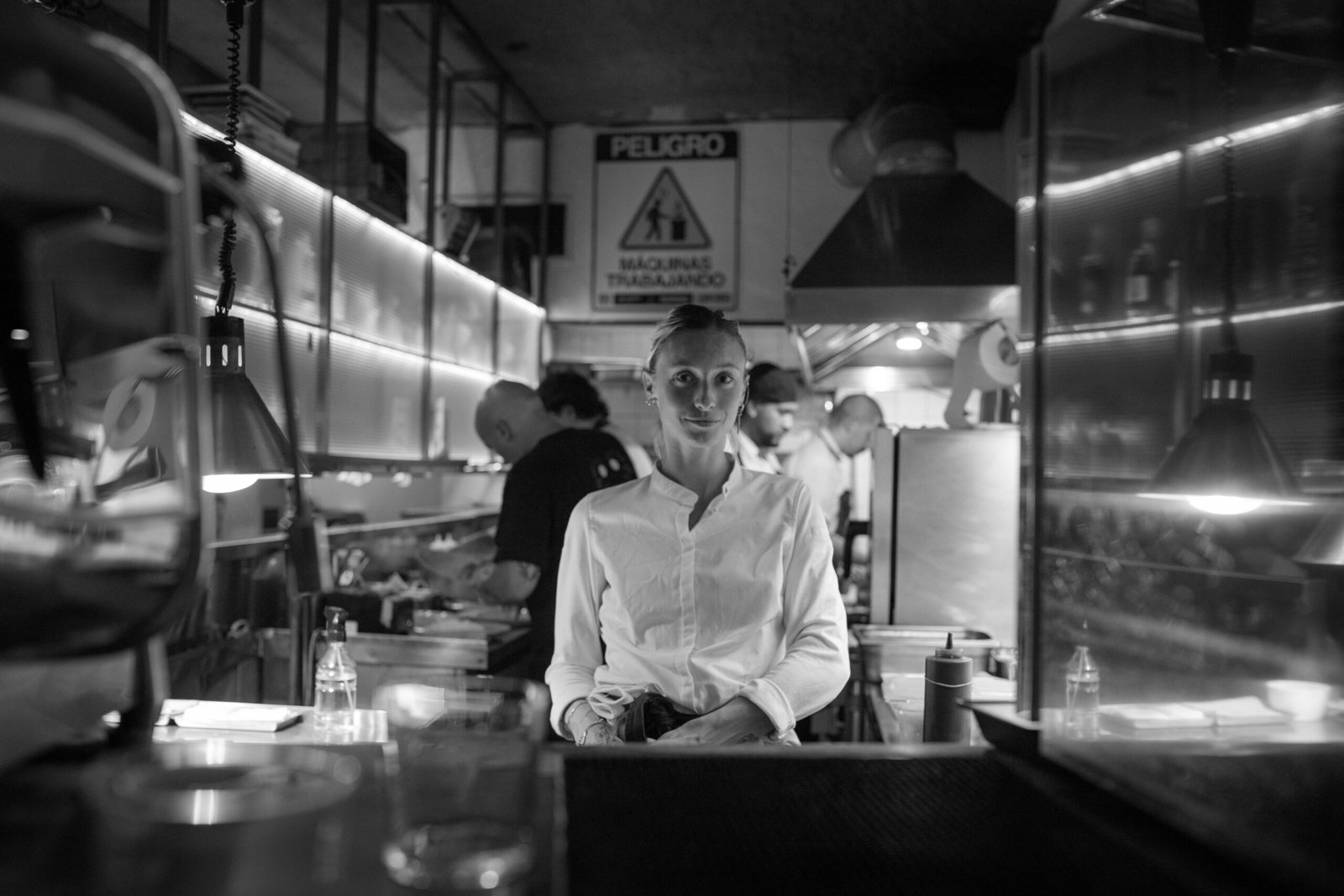
Maria Clara Corso Rodriguez
I grew up in a home where food was always homemade. My mother had learned in the countryside, and she raised us with very few packaged products. Everything was cooked with our hands, and food was an act of love. Nearly all my memories with family happened around the table, and that shaped me in ways I didn’t realize until later.
I didn’t always know this would be my career, but the idea took root during childhood vacations in Patagonia. I would sit with a raspberry tart in front of me, staring out at the mountains, and dream of owning a tea house one day. That was my first vision of hospitality.
I studied gastronomy at UADE and IAG in Buenos Aires. While in school, I started my own pastry project, and soon after graduating, I moved abroad. Barcelona was my first stop, then Versailles, where I worked in a Michelin-starred restaurant. That time in France changed me forever. I was young, inexperienced for a kitchen at that level, but I pushed myself to survive and to keep my place. That pressure pushed me to my limits, and it showed me this was what I truly wanted: professional cooking and service.
When I returned to Argentina during the pandemic, I joined Alo’s Bistro, eventually becoming head chef. I was still young, but it taught me how to lead and run a restaurant. Later, alongside Lucas and Félix (my friends and business partners), we opened Mad Pasta House, a modern, fresh pasta restaurant, and soon after, Mad Pasta Company, our delivery brand. Today, I’m just months away from opening my dream: Garabato Bistro, a neo-bistro built with Lucas, my partner in life and in business.
No one ever teaches us what real cooking is like. My experiences have always been a journey of giant leaps and bounds, skipping many steps at once, but with a considerable learning curve. From the moment I stepped into a professional kitchen and experienced firsthand what it entails, despite fears and frustrations, I decided this was what I wanted to dedicate myself to. The pressure I’ve experienced at every step of my career has pushed me to the highest limits I can reach. This constant hunger for more drives me to continue growing and learning in this beautiful industry.
No one teaches us what real cooking is. Every new leap, such as France, Alo’s, and Mad Pasta, came with significant challenges, but also big lessons. I’ve had to learn quickly, sometimes skipping steps, sometimes failing, but always pushing forward. My philosophy has grown out of that: work hard, give your best, and demand excellence, but never at the expense of health or respect. I believe in caring for our teams as much as we care for the food, respecting breaks, pushing hard when needed, and always leading in a fair way.
Cooking has also been my refuge. During difficult times, focusing on a cutting board or a dish gave me peace. Even though the kitchen is intense, for me, it can feel like meditation. It’s where I disconnect from everything else and reconnect with myself.
Opening Mad Pasta House at 27 was one of the proudest milestones of my life. And now, with Garabato Bistro, I feel all the years of effort, sacrifice, and saving coming together. It’s proof that the hunger to grow and to keep creating never leaves me.
What I love most about this industry is the feeling of a restaurant full of people, a team working together like a family. What frustrates me is how fragile teams can be. How hard it is to build and rebuild them, but when it works, when everyone treats the project as if it were their home, there’s nothing more rewarding.
I chose to stay in Argentina because I believe in its future. We have incredible products, but we still need better logistics and delivery systems. If chefs and restaurant owners work together, we can take Argentine gastronomy to the top. That’s the dream I want to help build.
Photo credits to @cove.foodphoto
Secret Sauce
- What’s the most unexpected ingredient you’ve ever worked with, and how did it change your perspective on cooking?
I don’t know if it’s the most unexpected product, but it’s one of the products I enjoy working with the most: artichoke. I like to clean them carefully and with lots of love, preserve them in oil, and then fry them. It’s a product that requires a lot of love to be perfect, and I appreciate the effort that goes into making it so. It shows when it was given love or just made like that.
- What’s your “guilty pleasure” meal?
I’m a big fan of good French fries and a great hamburger. There’s nothing better!
- A food trend that you hate and why?
Although I love eating it, I’m pretty bothered by avocado toast. There could be a much wider variety of options, and sometimes the globalization of avocados does more harm than many other things that are criticized.
- What’s the craziest shift you’ve ever worked in the kitchen? What happened, and how did you manage to get through it?
I have had to live culinary experiences with people with addictions, and it is something that I have suffered greatly from.
5. What happened, and how did you manage to get through it?
I think you overcome these moments by understanding that a person with addictions is sick or chooses to be, and you can’t follow the madness of such a person. Not letting others determine your limitations is important, and not being swayed by the altered desires of these people helps you focus and make bold decisions.
- What tips would you give to other cooks and chefs to help them navigate their culinary careers and find peace amid the chaos of the kitchen?
To give it their all and to work hard. Dreams always come true if you put in the effort and work for them. You need to be prepared for opportunities, whether they come your way or you seek them out, and work toward achieving your clear goals.
- What’s an underrated ingredient and why?
Truffles are overrated and misused in most places. I like them a lot and use them frequently, but we’ve discovered the best ways to use, activate, and enhance their flavor. I hate it when they’re served cold and untreated. I think they’re not worth the price tag at that point, but with proper care, they are.
8. What’s a must-try dish from your kitchen or the one you’re proudest to have prepared?
My favorite dish I’ve ever made was a winter salad with the Asteraceae family. Candied and fried artichokes, crispy-cooked Jerusalem artichoke, sliced yacon, sunflower bagna cauda, and an artichoke and chamomile soup.
About Your City!
Argentina
- If Anthony Bourdain or a chef came to your city, what would be the perfect tour itinerary from breakfast to dinner?
I would definitely bring them to my pasta restaurant in Martinez, Mad Pasta House. Also, to my neo-bistro in Nuñez. I would take them to the tavern “La Sarita” in Florida, in the northern part of Buenos Aires, where I live. I would take them for a walk and introduce them to “La Valiente,” the bakery owned by my great friend German. If I could, I would take them to Bebop, a jazz bar, and then we would have dinner at Don Juli, or my favorite in Palermo. I think it’s very interesting to get to know Mendoza, its wines, and its winemakers. And Ushuaia is a great place to visit, too.
Law Follows Order. Food Embraces Imperfection.
Humans Of The Kitchen
From Sunday lumpia to New York’s SoloDiner, Kevin redefines Filipino food while building kitchens rooted in empathy.
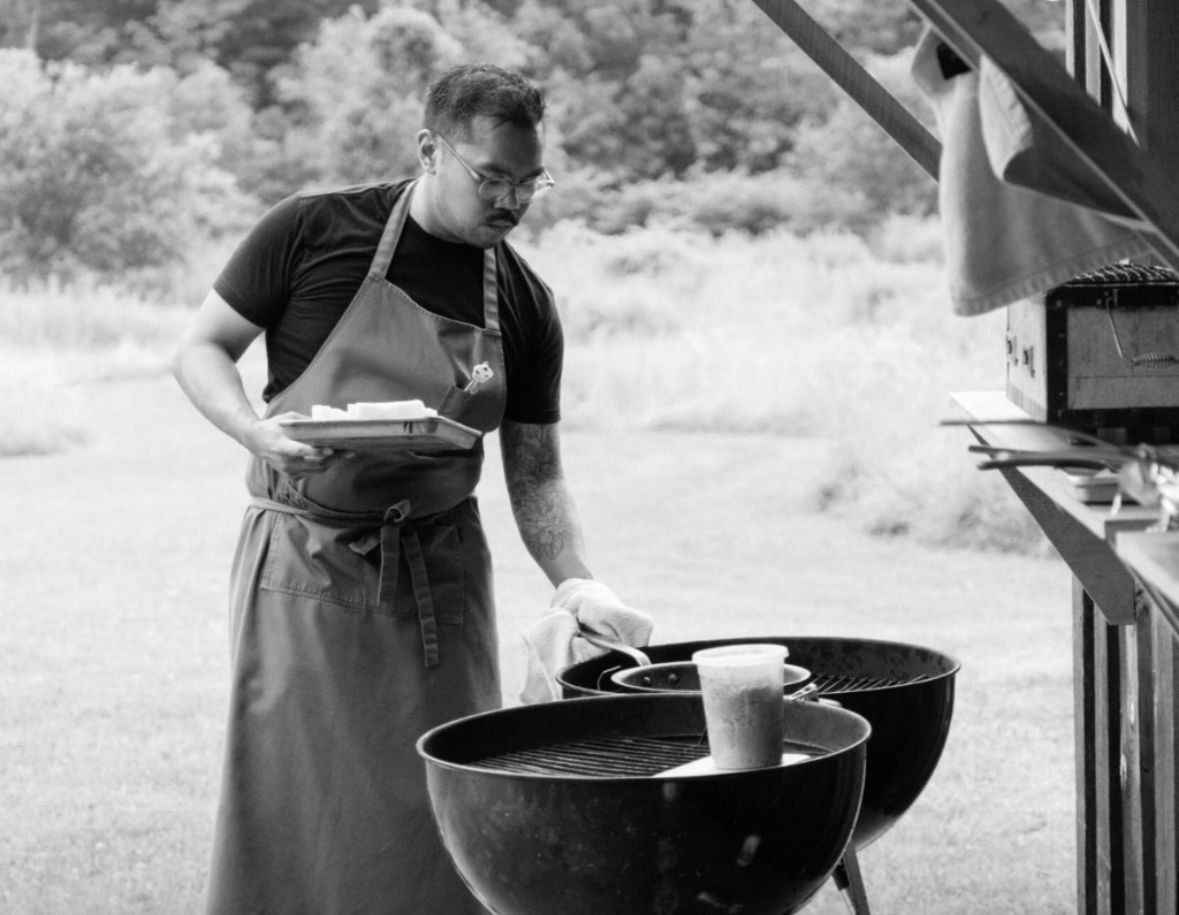
Kevin Cardenas
Sunday afternoons were sacred in my house. After mass, my mom and aunties would gather around the dining table with neon-colored bowls, chopping vegetables for lumpia and pancit. The smell of garlic frying filled the air, layered with the sound of gossip that flowed as easily as the oil in the pan. That’s where it started for me, food as a connection and love.
For a long time, though, I wasn’t supposed to be a chef. My family wanted me to be a lawyer. A safe path, a stable life. And for a while, I was on track for it. But when I eventually stepped into a kitchen, something clicked. Cooking itself came naturally to me, but all those years of studying, negotiating, and writing contracts turned out to be the real training. The food might be the passion, but running a kitchen means you need both the craft and the business. That “previous life” gave me the tools to survive beyond the stove.
My first kitchen job came when I was 18 or 19, working as a server while in university. I’d already been cooking basic meals for myself at home, but one day the kitchen needed extra help and I started peeling potatoes, picking herbs, and washing lettuce. The owner asked me, “When are you going to cook in the kitchen? You seem to know what you’re doing.” I told him I never had. He replied, “It’s like cooking at home, except you do the same thing 200 times a night and you can’t mess up.” That was it. I was in.
I initially taught myself to cook, inspired by shows like “Mind of a Chef” that explored the thought processes behind chefs’ actions. This sparked my natural curiosity about the nuances of food and cooking. There’s value in seeing things differently, acknowledging that nature isn’t perfect.
Being the youngest in the kitchen had its challenges. Most of my coworkers were in their 30s, seasoned veterans who had been at it for years. I tried to learn from everyone, but eventually I focused on the head chef. It wasn’t about dismissing the others; it was about finding the source of truth that aligned with where I wanted to go. That lesson, filtering information, cherry-picking guidance, and shaping it into my own, has carried me through my entire career.
Today, what keeps me going is my team. They are talented, diverse, and unafraid to challenge me. As a chef, it’s easy to get stuck in your own head and vision, but they remind me to stay open, to listen, and to keep improving. Some of my proudest moments have been rooted in empathy, like when my sous chef felt overwhelmed and unappreciated. Instead of being defensive, I listened. We worked through it together, and our relationship grew stronger. Those lessons, patience, listening, and humility have shaped me just as much as the food itself.
SoloDiner, our pop-up group, is another milestone that fills me with pride. In our first year alone, we hosted 34 pop-ups across New York City. It was nonstop, sometimes grueling, but when we celebrated our first anniversary collaborating with EHK Wines and Petrossian caviar, I finally felt the weight of what we had built. It wasn’t just about the food; it was about community, creativity, and resilience.
In the kitchen, my philosophy is simple: understand the “why” and embrace imperfection. Mother Nature isn’t perfect, neither are we. The produce might not look the way we want it to, the marinade might sit longer than intended, and sometimes those deviations make the dish even better. For me, cooking is about curiosity, flexibility, and remembering the purpose behind what we do.
As a Filipino-American, I’ve often felt caught between being “too American” or “not Filipino enough.” Our food, like our identity, is layered with Spanish, Japanese, and American influences. And with SoloDiner, we’re not trying to “bridge the gap” outright, but we’re definitely playing in that space, introducing Filipino food in a way that’s respectful of tradition while also current, fun, and accessible.
What I love most about this industry is its selflessness. We’re tuned in to the needs of others to such a degree that it becomes second nature. But what frustrates me is how little of that care gets extended inward to the very people making it all possible. Too many kitchens still run on intimidation, yelling, or fear. I’m working to change that. My approach is softer: embrace the failures, own them, and learn from them, but do it in a way that builds people up instead of tearing them down.
At the end of the day, we know how to take care of guests; that much is certain. My hope is that the industry learns to take care of its people with the same devotion. That’s the kind of culture I want to pass forward.
Secret Sauce
- What’s the most unexpected ingredient you’ve ever worked with, and how did it change your perspective on cooking?
There was not a singular ingredient that changed my perspective, but rather a process that did: fermentation. When I first learned about fermentation, I was a line cook, and it was just an ingredient. But then I ran out of lacto-fermented tomatoes for the first time. Little did I know that it was a process that took multiple days and specific conditions to accomplish. After that, I became curious; I deep dived into the world of fermentation, and I was fascinated by it. The most beautiful part about it (which had made me appreciate food scarcity and waste more) was that you are essentially taking a product at its peak and preserving that nuance in a specific time and place. That’s so cool and beautiful.
- What’s your “guilty pleasure” meal?
Chinese takeout: General Tso’s Chicken with pork fried rice.
- A food trend that you hate and why?
Everything in tower form. Higher doesn’t mean better.
- What’s the craziest shift you’ve ever worked in the kitchen? What happened, and how did you manage to get through it?
Thanksgiving service at EMP.
5. What happened, and how did you manage to get through it?
It was such a rush, marathon, and trial to get through that service. Our cover counts were so high, production lists were insane, and we were all definitely sleep-deprived. I managed to get through that by leaning on my team to keep me locked in and focused.
- What tips would you give to other cooks and chefs to help them navigate their culinary careers and find peace amid the chaos of the kitchen?
Listen, listen, and listen. We always say that we need to walk before we can run, which is true. But folks need to hear more first before anything. And that’s not just in cooking, but also in understanding why people do what they do, the reasoning behind their choices, and why they prefer to do things differently or more challenging than others. Listening builds a foundation and skills that will carry you the rest of the way.
- What’s an underrated ingredient and why?
Vinegars! A delicious Filipino spiced coconut vinegar is a beautiful acidic pop.
8. What’s a must-try dish from your kitchen or the one you’re proudest to have prepared?
The last dish that I loved creating and executing was our Tamarind-Glazed Skirt Steak. The inspiration was sinigang, which is a sour soup made with tamarind, tomatoes, and bitter melon. I glazed dry-aged skirt steak with a tamarind paste, fish sauce, and soy, and then grilled it. Then, I served it with a Hawaiian macaroni salad and heirloom tomatoes. Such a beautiful summer dish that was very yummy.
About Your City!
New York City
- If Anthony Bourdain or a chef came to your city, what would be the perfect tour itinerary from breakfast to dinner?
- Breakfast: WinSon – Scallion Pancake Egg and Cheese.
- Lunch: Thai Diner (definitely get the disco fries and the crab fried rice).
- Pop-Up: Check out the 8it app for the whole run-down…slight plug for SoloDiner for Filipino food.
- Dinner: Bar Americano.
- Bars: Bar snack, Romeo’s, Compagnie Flatiron, Clemente Bar, Whiskey Tavern.
Reaching the High Without Losing the Ground
Humans Of The Kitchen
From family preserves to fine dining, she learned that the highest achievement is a kitchen rooted in humanity.
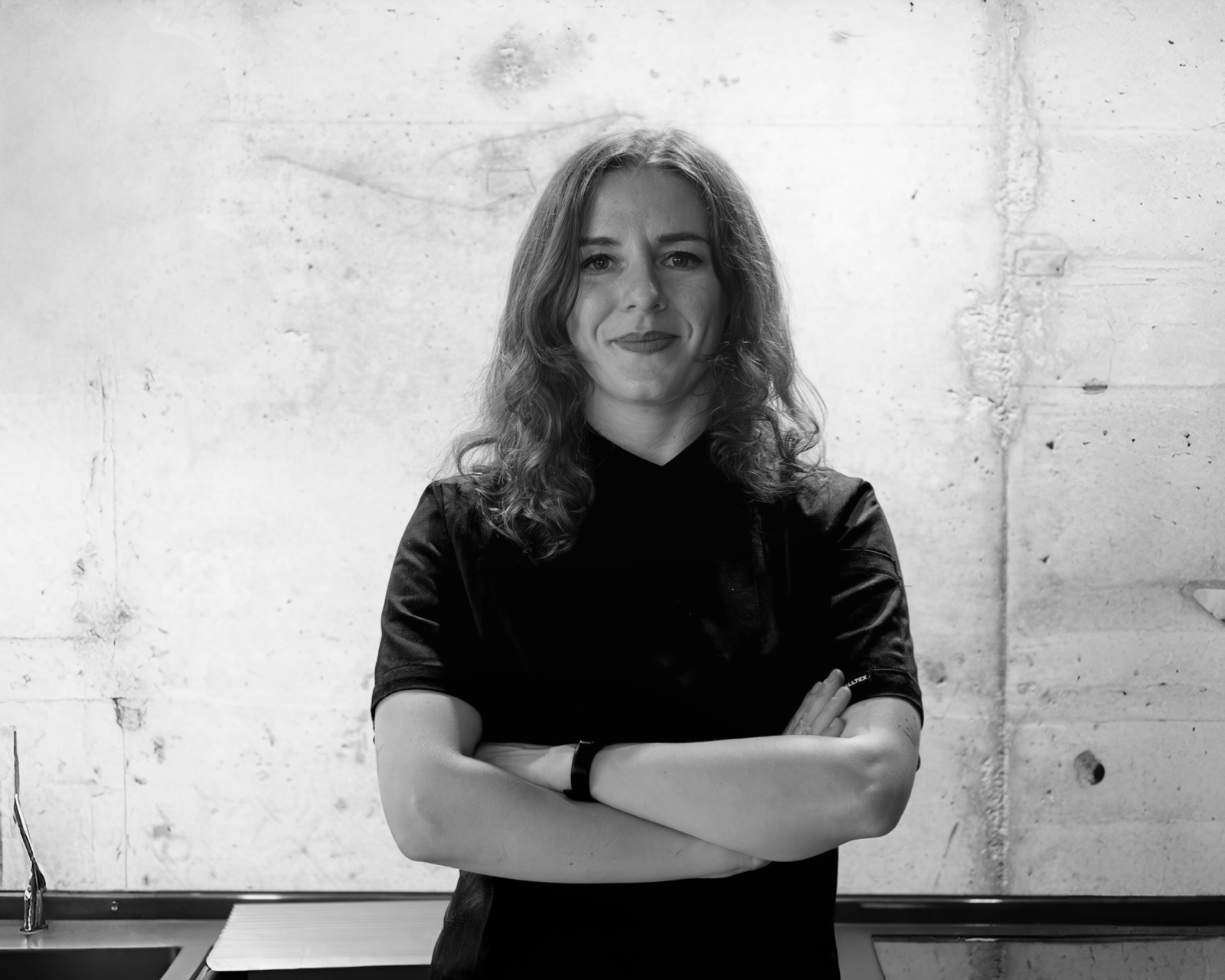
Hristiana Dimitrova
I grew up in Varna, Bulgaria, in a family that loved to cook. My mother, aunt (the baking queen), and grandparents filled our home with flavors, from sneaky spices to garden-fresh produce. Summers were spent preserving nature’s bounty: making jams, pickles, and exchanging eggs and cheese in our village. We may not have traveled much, but our kitchen and dining room were the heart of our home, where we connected and shared warmth. This deep-rooted appreciation for food is a big reason I chose this path, as it always represented love and nurture in my life.
Before kitchens, I studied Events Management, my first passion. Moving abroad and facing a language barrier, I turned to cooking, which I loved. I began with small jobs, progressed to private gigs, and eventually trained at Hotelschool Ter Duinen in Belgium, one of Europe’s top culinary schools. I expected to learn cooking techniques, but instead gained knowledge in service, wine, entrepreneurship, and hospitality. This holistic education showed me that food is about the whole experience, not just the plate.
My first real kitchen was at the Holiday Inn Express by Glasgow Airport, where I worked as a Guest Service Assistant. I did everything from bartending to setting up breakfast and plating desserts. It wasn’t glamorous, but it gave me structure and discipline. I’ll never forget my manager, Gary, taking off his blazer in the middle of a rush and jumping into the kitchen, frying potatoes alongside us. That moment taught me that leadership is about stepping in.
One of the biggest challenges I faced early on was being exploited by senior staff. As a trainee, I didn’t fully understand my role and was often taken advantage of. Over time, I recognized this mistreatment and learned to set boundaries, communicate clearly, and create a respectful environment.
Another major challenge was the physical toll of the job, with extended hours and constant soreness. I found ways to manage it by taking short breaks, sitting when possible, practicing mindful eating, reducing alcohol consumption during the workweek, and stretching after shifts. These changes significantly improved my physical and mental well-being.
I find inspiration in many places, such as hiking, concerts, raves, and food trucks at festivals. Stepping away from the kitchen often sparks my best ideas. Traveling has also profoundly shaped me; observing how other cultures use ingredients and experiencing the hospitality in small cafés and street stalls enriches my perspective. Those moments nourish me just as much as the work itself.
One of the people who shaped me most was Chef Rein, my instructor in Belgium. He never yelled, never let us drown completely, but also never gave us easy answers. He taught me that leadership in kitchens isn’t about intimidation but about guiding, protecting, and giving people the confidence to grow. I carry his lessons with me every time I lead a team.
I’ve worked in Michelin-starred dining, in oyster bars, in small bistros, and in casual spaces. I’ve been proud of the exams I’ve passed, the events I’ve catered, and the menus I’ve created. But maybe the most important milestone was realizing I could step away from fine dining and still be proud. That I could find my place in private gigs, pop-ups, and casual food, reconnecting with why I loved cooking in the first place.
My philosophy is simple: the ingredient is the flavor. Respect the seasons, cook with intention, and lead with kindness. I want my kitchens to feel calm, focused, and fair, places where people can thrive, not just survive.
Because I’ve also seen the worst of it: burnout, addiction, the old mentality that exhaustion equals value, I want no part of that. Kitchens should be human-centered, with balance, communication, and emotional intelligence as much a part of the training as knife skills.
Food has always been my way of feeling grounded, of connecting with others, of creating joy. My hope for the future is an industry that holds on to that humanity and values the people behind the plates as much as the plates themselves.
Secret Sauce
- What’s the most unexpected ingredient you’ve ever worked with, and how did it change your perspective on cooking?
Miso. I discovered it through a friend just before we started shooting food content for a vegan brand. At first, I had no clue what to do with it, but once I started playing around, I realized it’s ridiculously versatile. Now I throw it into pretty much everything, from meats and sauces to even desserts. It’s got this crazy depth of flavor and some awesome health benefits too. Honestly, it’s one of those ingredients I can’t stop using.
- What’s your “guilty pleasure” meal?
A McDonald’s cheeseburger and fries, or a frozen pizza after a busy shift. Sorry, not sorry!
- A food trend that you hate and why?
I wouldn’t say I hate it, but I struggle to connect with molecular gastronomy, especially when it’s used more to impress than to genuinely enhance the dining experience. I fully respect the science and creativity behind it. The techniques can be clever, and when used with purpose, they can elevate a dish in truly interesting ways. But too often, it feels like style over substance. Sometimes the ingredients get lost in the transformation. They’re pushed too far, overly manipulated, or artificially enhanced. For example, if the tomatoes your supplier brought in are not at their peak, turning them into water, then back into a gel, adding sugar, vinegar, or “magical powders” to make them taste better doesn’t solve the problem; it just masks it. I’d rather replace the ingredient entirely than try to force something that isn’t at its best. To me, great cooking is about honesty and letting ingredients speak for themselves. Molecular gastronomy has its place, but I prefer food that’s grounded and satisfying naturally.
- What’s the craziest shift you’ve ever worked in the kitchen? What happened, and how did you manage to get through it?
There have been so many intense shifts that it’s hard to choose just one. Some of the wildest have been opening nights at new kitchens I’ve helped launch. There’s a unique energy in those moments, and no matter how well you prepare, the unexpected always finds a way in.
5. What happened, and how did you manage to get through it?
There are shifts where everything seems to go wrong at once. Unexpected bookings flood in, guests all arrive at the same time, a menu item runs out mid-service, or we’re short-staffed with team members still in training. Sometimes, there’s this eerie calm just before it all kicks off, and you can almost feel it coming. You just know, “Tonight’s going to be hell.” In those moments, I’ve learned to stop and ask myself: How bad could it be, really? That perspective helps. I’ve never had a guest walk out, never faced a life-threatening allergy issue, and never seen a serious staff accident. That reality grounds me. It reminds me that no matter how intense things feel, they’re still manageable.
My approach is to double down on focus, stay clear-headed, and communicate constantly with the team. Compassion and calm are crucial. I try to keep morale steady and remind everyone to focus on what’s within our control. And honestly, sometimes things just work out. Someone steps up, a solution appears, or things resolve in ways you didn’t expect. I like to joke that a “kitchen fairy” shows up and saves the day. But really, it’s just the power of teamwork, adaptability, and staying cool under pressure.
6. What tips would you give to other cooks and chefs to help them navigate their culinary careers and find peace amid the chaos of the kitchen?
Firstly, never settle for a toxic work environment or culture. Anything that damages your mental health comes at too high a cost. Be fully aware of what you’re sacrificing and what you’re willing to give. Have clear goals and a strong sense of purpose in every role you take on. When your vision is clear, it becomes easier to push through the toughest shifts. Always practice kindness, no matter the pressure. Keep the chef ego in check. Humility and respect go a long way in building a strong team and a positive kitchen culture. And above all, take care of yourself. This industry demands both physical and mental strength, and your body and energy are your most valuable assets. Treat yourself with compassion and remember: your well-being is not just about your career, it’s about your life.
7. What’s an underrated ingredient and why?
Whey. It can be used in baking, for sauces or marinades, or for fermentation. Excellent byproduct, packed with outstanding nutritional properties.
8. What’s a must-try dish from your kitchen or the one you’re proudest to have prepared?
Something made with the fresh produce from my grandparents’ garden and a wild-caught fish from my uncle.
About Your City!
Varna, Bulgaria
- If Anthony Bourdain or a chef came to your city, what would be the perfect tour itinerary from breakfast to dinner?
I’ve only been back in my city for eight months after living in Belgium, so I’m still rediscovering it. It’s not a fine-dining capital. Its soul is in street food and the rich mix of Balkan and Eastern flavors.
We’d start the morning with banitsa and ayran or boza, ideally my grandmother’s, or at a bakery nearby, a famous site The Varna Cathedral, they offer a great banitsa, made with sourdough. Lunch would be at a no-frills local spot for tripe soup, bold, unapologetic, and the kind of dish you either love instantly or never forget trying.
For dinner, we’d drive north along the coast to a mussel farm, eating Black Sea mussels and freshly caught seafood with nothing between you and the ocean but the sound of the waves.
The region is also home to wine festivals and tastings, where you can sip crisp, aromatic whites and mineral-rich reds from vineyards cooled by the Black Sea breeze, the perfect pairing to the seafood, and an experience that’s still off most travelers’ radars.
I’d also recommend Varna Winekend, a yearly festival celebrating local wines, with some awesome foodie bites as well, a perfect way to taste the region and soak in the local vibe.

